The Future of Work: Gig Economy and Leadership
VerifiedAdded on 2020/05/28
|32
|8597
|147
AI Summary
This assignment presents a case study of Widespace, a technology venture experiencing growth and cultural evolution. Students are tasked with analyzing Widespace's business model, leadership style under its CEO Wennberg, and the challenges it faces as a maturing company. The analysis should draw upon relevant theories and concepts from strategic management, organizational behavior, and entrepreneurship to provide insights into Widespace's future success.
Contribute Materials
Your contribution can guide someone’s learning journey. Share your
documents today.
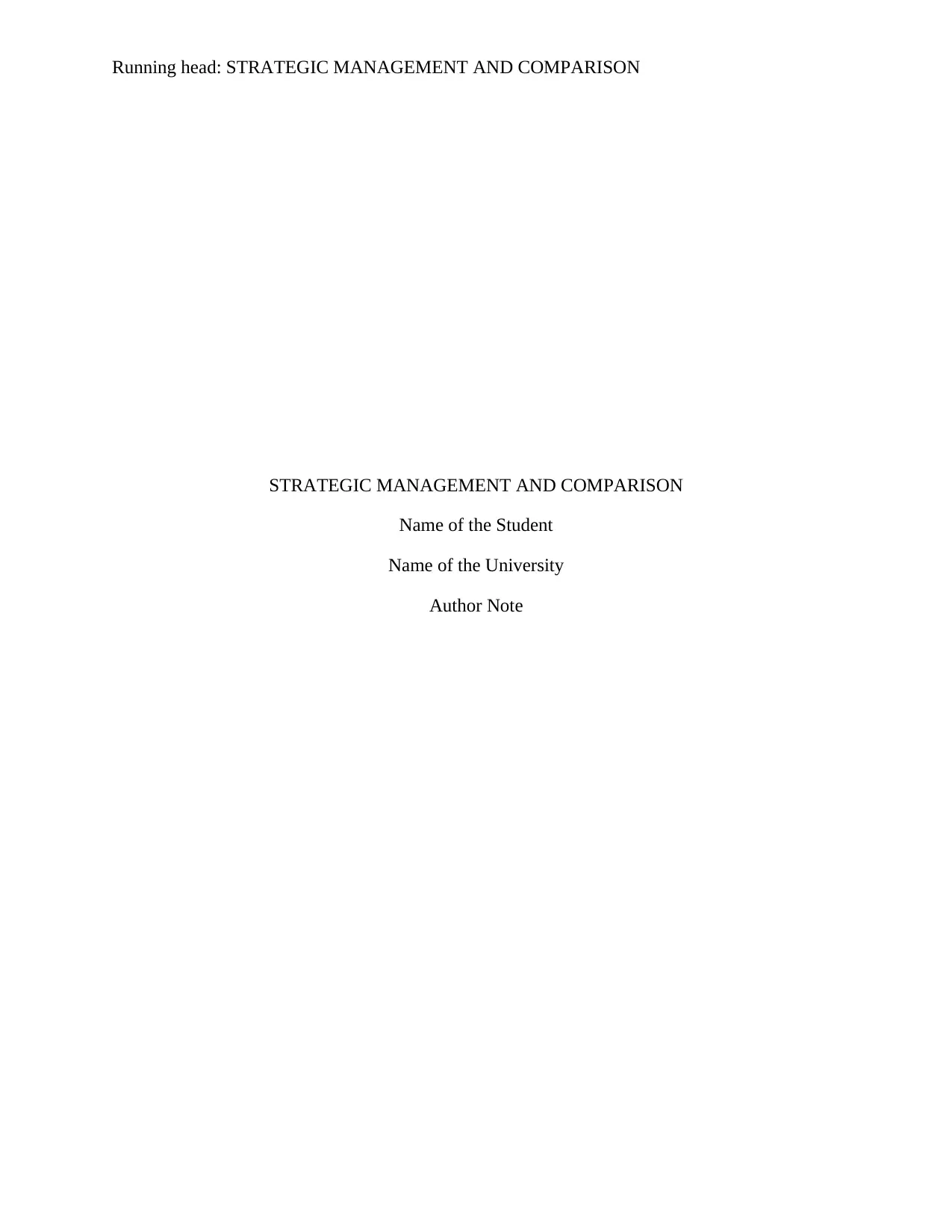
Running head: STRATEGIC MANAGEMENT AND COMPARISON
STRATEGIC MANAGEMENT AND COMPARISON
Name of the Student
Name of the University
Author Note
STRATEGIC MANAGEMENT AND COMPARISON
Name of the Student
Name of the University
Author Note
Secure Best Marks with AI Grader
Need help grading? Try our AI Grader for instant feedback on your assignments.
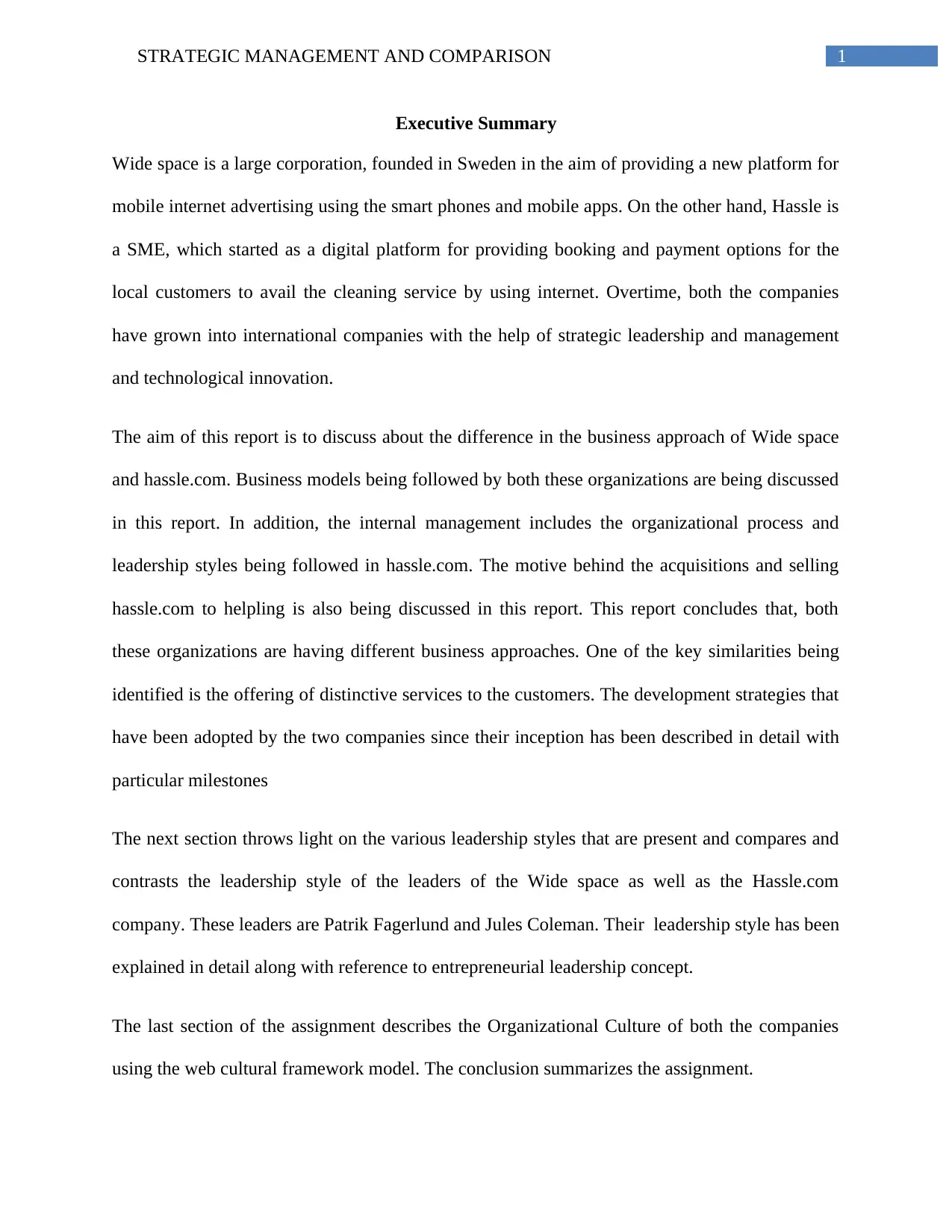
1STRATEGIC MANAGEMENT AND COMPARISON
Executive Summary
Wide space is a large corporation, founded in Sweden in the aim of providing a new platform for
mobile internet advertising using the smart phones and mobile apps. On the other hand, Hassle is
a SME, which started as a digital platform for providing booking and payment options for the
local customers to avail the cleaning service by using internet. Overtime, both the companies
have grown into international companies with the help of strategic leadership and management
and technological innovation.
The aim of this report is to discuss about the difference in the business approach of Wide space
and hassle.com. Business models being followed by both these organizations are being discussed
in this report. In addition, the internal management includes the organizational process and
leadership styles being followed in hassle.com. The motive behind the acquisitions and selling
hassle.com to helpling is also being discussed in this report. This report concludes that, both
these organizations are having different business approaches. One of the key similarities being
identified is the offering of distinctive services to the customers. The development strategies that
have been adopted by the two companies since their inception has been described in detail with
particular milestones
The next section throws light on the various leadership styles that are present and compares and
contrasts the leadership style of the leaders of the Wide space as well as the Hassle.com
company. These leaders are Patrik Fagerlund and Jules Coleman. Their leadership style has been
explained in detail along with reference to entrepreneurial leadership concept.
The last section of the assignment describes the Organizational Culture of both the companies
using the web cultural framework model. The conclusion summarizes the assignment.
Executive Summary
Wide space is a large corporation, founded in Sweden in the aim of providing a new platform for
mobile internet advertising using the smart phones and mobile apps. On the other hand, Hassle is
a SME, which started as a digital platform for providing booking and payment options for the
local customers to avail the cleaning service by using internet. Overtime, both the companies
have grown into international companies with the help of strategic leadership and management
and technological innovation.
The aim of this report is to discuss about the difference in the business approach of Wide space
and hassle.com. Business models being followed by both these organizations are being discussed
in this report. In addition, the internal management includes the organizational process and
leadership styles being followed in hassle.com. The motive behind the acquisitions and selling
hassle.com to helpling is also being discussed in this report. This report concludes that, both
these organizations are having different business approaches. One of the key similarities being
identified is the offering of distinctive services to the customers. The development strategies that
have been adopted by the two companies since their inception has been described in detail with
particular milestones
The next section throws light on the various leadership styles that are present and compares and
contrasts the leadership style of the leaders of the Wide space as well as the Hassle.com
company. These leaders are Patrik Fagerlund and Jules Coleman. Their leadership style has been
explained in detail along with reference to entrepreneurial leadership concept.
The last section of the assignment describes the Organizational Culture of both the companies
using the web cultural framework model. The conclusion summarizes the assignment.

2STRATEGIC MANAGEMENT AND COMPARISON
Table of Contents
Introduction......................................................................................................................................3
Brief history of the companies.....................................................................................................3
Strategic analysis and SWOT analysis........................................................................................4
Products and services...................................................................................................................7
Growth Patterns...............................................................................................................................9
Generic and Developmental Strategies..........................................................................................11
Development Strategies.............................................................................................................16
Organizational Culture...................................................................................................................22
Web cultural framework............................................................................................................22
Conclusion.....................................................................................................................................27
References......................................................................................................................................28
Table of Contents
Introduction......................................................................................................................................3
Brief history of the companies.....................................................................................................3
Strategic analysis and SWOT analysis........................................................................................4
Products and services...................................................................................................................7
Growth Patterns...............................................................................................................................9
Generic and Developmental Strategies..........................................................................................11
Development Strategies.............................................................................................................16
Organizational Culture...................................................................................................................22
Web cultural framework............................................................................................................22
Conclusion.....................................................................................................................................27
References......................................................................................................................................28
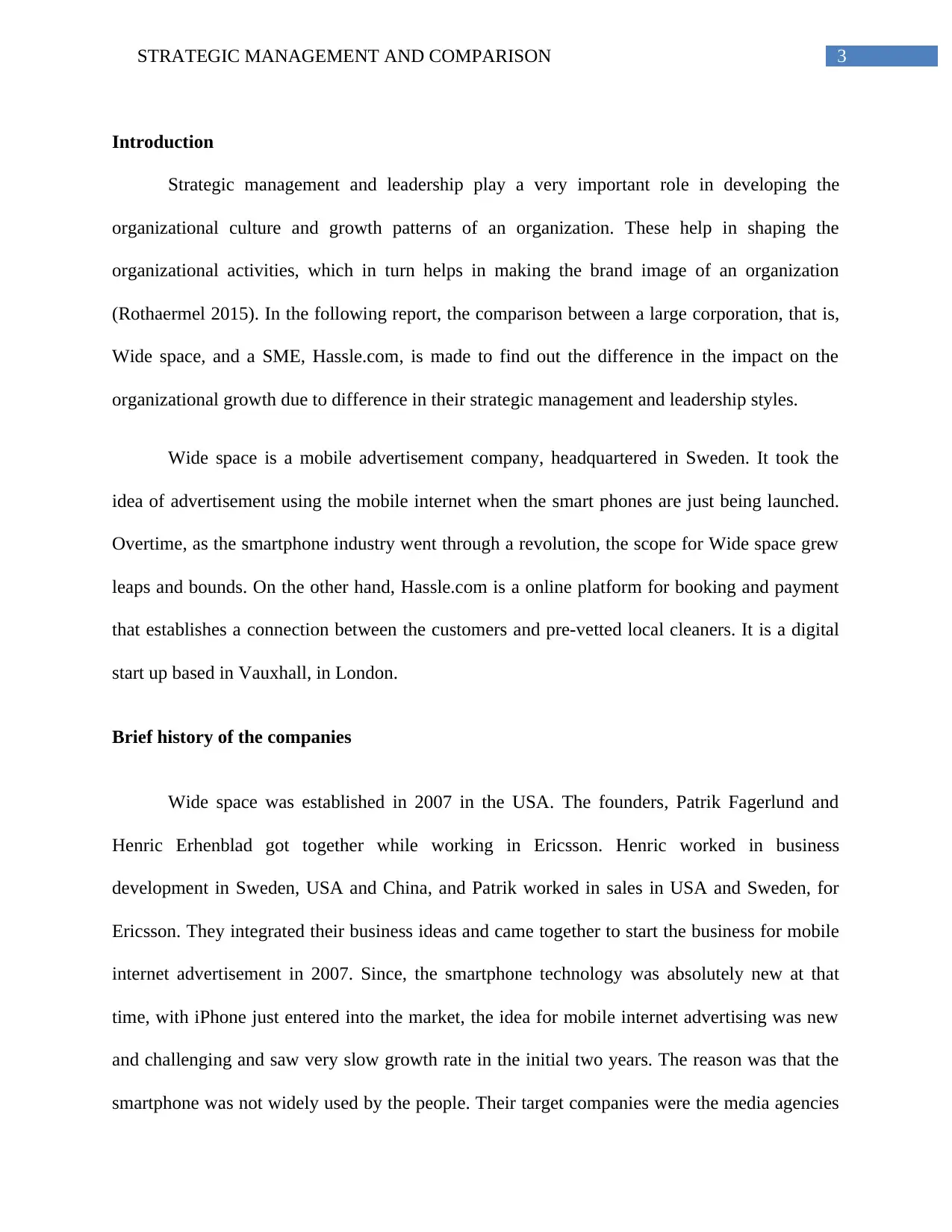
3STRATEGIC MANAGEMENT AND COMPARISON
Introduction
Strategic management and leadership play a very important role in developing the
organizational culture and growth patterns of an organization. These help in shaping the
organizational activities, which in turn helps in making the brand image of an organization
(Rothaermel 2015). In the following report, the comparison between a large corporation, that is,
Wide space, and a SME, Hassle.com, is made to find out the difference in the impact on the
organizational growth due to difference in their strategic management and leadership styles.
Wide space is a mobile advertisement company, headquartered in Sweden. It took the
idea of advertisement using the mobile internet when the smart phones are just being launched.
Overtime, as the smartphone industry went through a revolution, the scope for Wide space grew
leaps and bounds. On the other hand, Hassle.com is a online platform for booking and payment
that establishes a connection between the customers and pre-vetted local cleaners. It is a digital
start up based in Vauxhall, in London.
Brief history of the companies
Wide space was established in 2007 in the USA. The founders, Patrik Fagerlund and
Henric Erhenblad got together while working in Ericsson. Henric worked in business
development in Sweden, USA and China, and Patrik worked in sales in USA and Sweden, for
Ericsson. They integrated their business ideas and came together to start the business for mobile
internet advertisement in 2007. Since, the smartphone technology was absolutely new at that
time, with iPhone just entered into the market, the idea for mobile internet advertising was new
and challenging and saw very slow growth rate in the initial two years. The reason was that the
smartphone was not widely used by the people. Their target companies were the media agencies
Introduction
Strategic management and leadership play a very important role in developing the
organizational culture and growth patterns of an organization. These help in shaping the
organizational activities, which in turn helps in making the brand image of an organization
(Rothaermel 2015). In the following report, the comparison between a large corporation, that is,
Wide space, and a SME, Hassle.com, is made to find out the difference in the impact on the
organizational growth due to difference in their strategic management and leadership styles.
Wide space is a mobile advertisement company, headquartered in Sweden. It took the
idea of advertisement using the mobile internet when the smart phones are just being launched.
Overtime, as the smartphone industry went through a revolution, the scope for Wide space grew
leaps and bounds. On the other hand, Hassle.com is a online platform for booking and payment
that establishes a connection between the customers and pre-vetted local cleaners. It is a digital
start up based in Vauxhall, in London.
Brief history of the companies
Wide space was established in 2007 in the USA. The founders, Patrik Fagerlund and
Henric Erhenblad got together while working in Ericsson. Henric worked in business
development in Sweden, USA and China, and Patrik worked in sales in USA and Sweden, for
Ericsson. They integrated their business ideas and came together to start the business for mobile
internet advertisement in 2007. Since, the smartphone technology was absolutely new at that
time, with iPhone just entered into the market, the idea for mobile internet advertising was new
and challenging and saw very slow growth rate in the initial two years. The reason was that the
smartphone was not widely used by the people. Their target companies were the media agencies
Secure Best Marks with AI Grader
Need help grading? Try our AI Grader for instant feedback on your assignments.
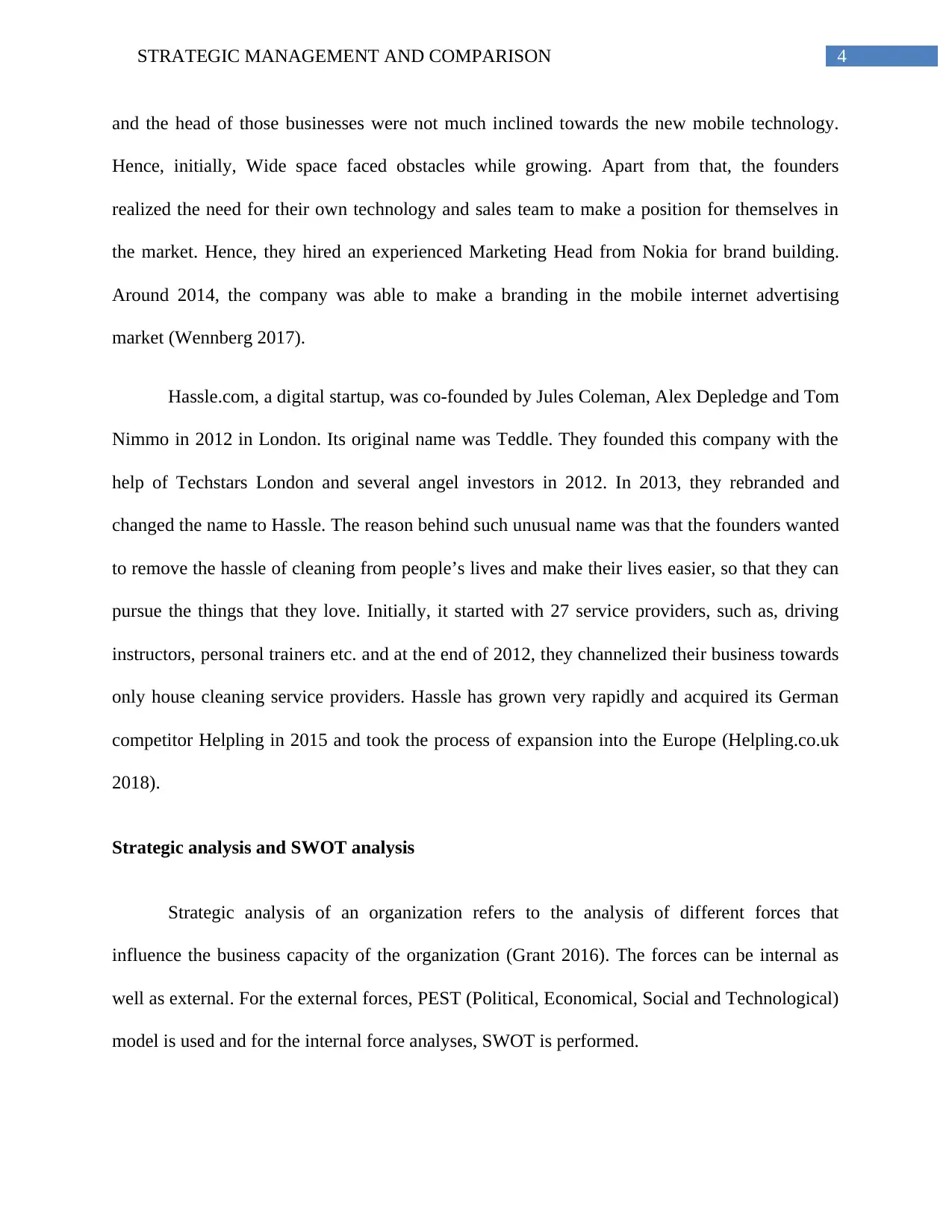
4STRATEGIC MANAGEMENT AND COMPARISON
and the head of those businesses were not much inclined towards the new mobile technology.
Hence, initially, Wide space faced obstacles while growing. Apart from that, the founders
realized the need for their own technology and sales team to make a position for themselves in
the market. Hence, they hired an experienced Marketing Head from Nokia for brand building.
Around 2014, the company was able to make a branding in the mobile internet advertising
market (Wennberg 2017).
Hassle.com, a digital startup, was co-founded by Jules Coleman, Alex Depledge and Tom
Nimmo in 2012 in London. Its original name was Teddle. They founded this company with the
help of Techstars London and several angel investors in 2012. In 2013, they rebranded and
changed the name to Hassle. The reason behind such unusual name was that the founders wanted
to remove the hassle of cleaning from people’s lives and make their lives easier, so that they can
pursue the things that they love. Initially, it started with 27 service providers, such as, driving
instructors, personal trainers etc. and at the end of 2012, they channelized their business towards
only house cleaning service providers. Hassle has grown very rapidly and acquired its German
competitor Helpling in 2015 and took the process of expansion into the Europe (Helpling.co.uk
2018).
Strategic analysis and SWOT analysis
Strategic analysis of an organization refers to the analysis of different forces that
influence the business capacity of the organization (Grant 2016). The forces can be internal as
well as external. For the external forces, PEST (Political, Economical, Social and Technological)
model is used and for the internal force analyses, SWOT is performed.
and the head of those businesses were not much inclined towards the new mobile technology.
Hence, initially, Wide space faced obstacles while growing. Apart from that, the founders
realized the need for their own technology and sales team to make a position for themselves in
the market. Hence, they hired an experienced Marketing Head from Nokia for brand building.
Around 2014, the company was able to make a branding in the mobile internet advertising
market (Wennberg 2017).
Hassle.com, a digital startup, was co-founded by Jules Coleman, Alex Depledge and Tom
Nimmo in 2012 in London. Its original name was Teddle. They founded this company with the
help of Techstars London and several angel investors in 2012. In 2013, they rebranded and
changed the name to Hassle. The reason behind such unusual name was that the founders wanted
to remove the hassle of cleaning from people’s lives and make their lives easier, so that they can
pursue the things that they love. Initially, it started with 27 service providers, such as, driving
instructors, personal trainers etc. and at the end of 2012, they channelized their business towards
only house cleaning service providers. Hassle has grown very rapidly and acquired its German
competitor Helpling in 2015 and took the process of expansion into the Europe (Helpling.co.uk
2018).
Strategic analysis and SWOT analysis
Strategic analysis of an organization refers to the analysis of different forces that
influence the business capacity of the organization (Grant 2016). The forces can be internal as
well as external. For the external forces, PEST (Political, Economical, Social and Technological)
model is used and for the internal force analyses, SWOT is performed.
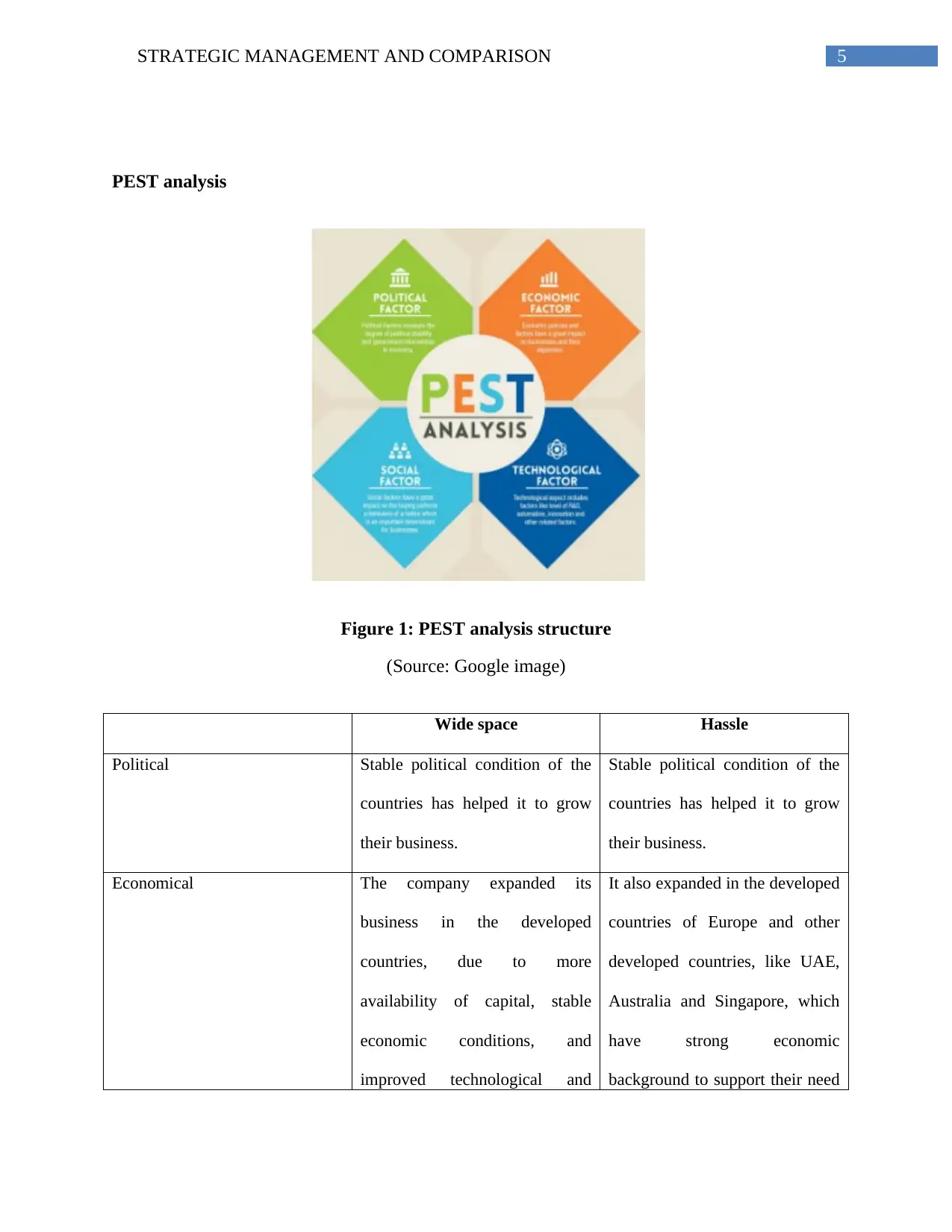
5STRATEGIC MANAGEMENT AND COMPARISON
PEST analysis
Figure 1: PEST analysis structure
(Source: Google image)
Wide space Hassle
Political Stable political condition of the
countries has helped it to grow
their business.
Stable political condition of the
countries has helped it to grow
their business.
Economical The company expanded its
business in the developed
countries, due to more
availability of capital, stable
economic conditions, and
improved technological and
It also expanded in the developed
countries of Europe and other
developed countries, like UAE,
Australia and Singapore, which
have strong economic
background to support their need
PEST analysis
Figure 1: PEST analysis structure
(Source: Google image)
Wide space Hassle
Political Stable political condition of the
countries has helped it to grow
their business.
Stable political condition of the
countries has helped it to grow
their business.
Economical The company expanded its
business in the developed
countries, due to more
availability of capital, stable
economic conditions, and
improved technological and
It also expanded in the developed
countries of Europe and other
developed countries, like UAE,
Australia and Singapore, which
have strong economic
background to support their need
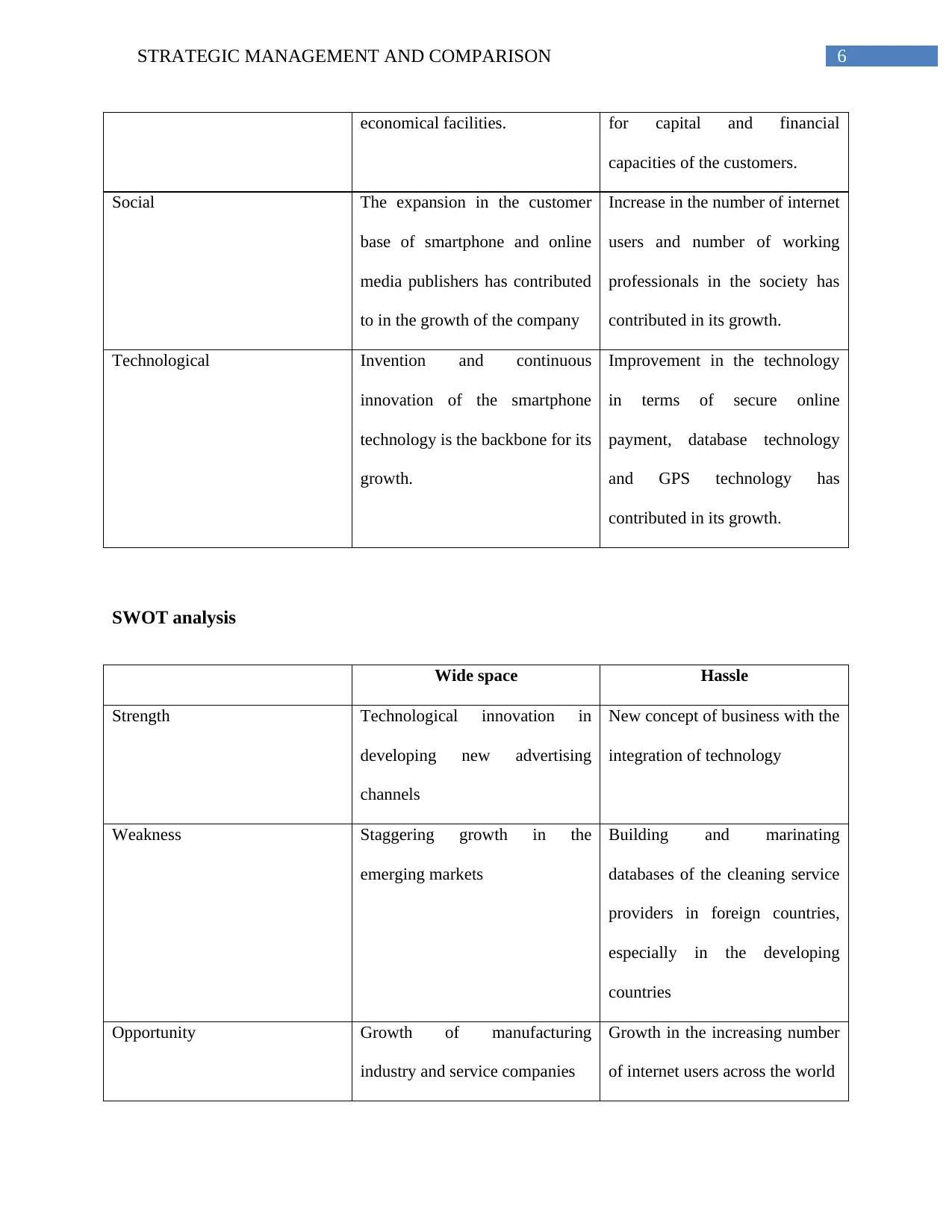
6STRATEGIC MANAGEMENT AND COMPARISON
economical facilities. for capital and financial
capacities of the customers.
Social The expansion in the customer
base of smartphone and online
media publishers has contributed
to in the growth of the company
Increase in the number of internet
users and number of working
professionals in the society has
contributed in its growth.
Technological Invention and continuous
innovation of the smartphone
technology is the backbone for its
growth.
Improvement in the technology
in terms of secure online
payment, database technology
and GPS technology has
contributed in its growth.
SWOT analysis
Wide space Hassle
Strength Technological innovation in
developing new advertising
channels
New concept of business with the
integration of technology
Weakness Staggering growth in the
emerging markets
Building and marinating
databases of the cleaning service
providers in foreign countries,
especially in the developing
countries
Opportunity Growth of manufacturing
industry and service companies
Growth in the increasing number
of internet users across the world
economical facilities. for capital and financial
capacities of the customers.
Social The expansion in the customer
base of smartphone and online
media publishers has contributed
to in the growth of the company
Increase in the number of internet
users and number of working
professionals in the society has
contributed in its growth.
Technological Invention and continuous
innovation of the smartphone
technology is the backbone for its
growth.
Improvement in the technology
in terms of secure online
payment, database technology
and GPS technology has
contributed in its growth.
SWOT analysis
Wide space Hassle
Strength Technological innovation in
developing new advertising
channels
New concept of business with the
integration of technology
Weakness Staggering growth in the
emerging markets
Building and marinating
databases of the cleaning service
providers in foreign countries,
especially in the developing
countries
Opportunity Growth of manufacturing
industry and service companies
Growth in the increasing number
of internet users across the world
Paraphrase This Document
Need a fresh take? Get an instant paraphrase of this document with our AI Paraphraser

7STRATEGIC MANAGEMENT AND COMPARISON
Threat Rising competition domestically
and internationally
Rising competition domestically
and internationally
Products and services
Wide space started the business with a commitment to offer premium advertisement for
mobiles. This highlights the facts that their products and technology includes the classical banner
advertisements along with adding the real customer value to the clients as well as to the end-
users. They have been providing the advertisements through different formats. Those are as
follows:
The Splash: full screen ad for three seconds during the loading of an app and clickable ad within
the app.
Video banner: video ads played directly in the app, becoming full screen when clicked and
becoming banner again after finishing playing.
Store locator: interactive map by displaying the street view in the banner for locating the nearest
store using the GPS technology of the smart phones.
Calendar: one click on the ad allows the user to set an event or reminder on the calendar on the
phone.
The Swipe: users can switch through unlimited number of images through one slide over the
advertisement.
Threat Rising competition domestically
and internationally
Rising competition domestically
and internationally
Products and services
Wide space started the business with a commitment to offer premium advertisement for
mobiles. This highlights the facts that their products and technology includes the classical banner
advertisements along with adding the real customer value to the clients as well as to the end-
users. They have been providing the advertisements through different formats. Those are as
follows:
The Splash: full screen ad for three seconds during the loading of an app and clickable ad within
the app.
Video banner: video ads played directly in the app, becoming full screen when clicked and
becoming banner again after finishing playing.
Store locator: interactive map by displaying the street view in the banner for locating the nearest
store using the GPS technology of the smart phones.
Calendar: one click on the ad allows the user to set an event or reminder on the calendar on the
phone.
The Swipe: users can switch through unlimited number of images through one slide over the
advertisement.
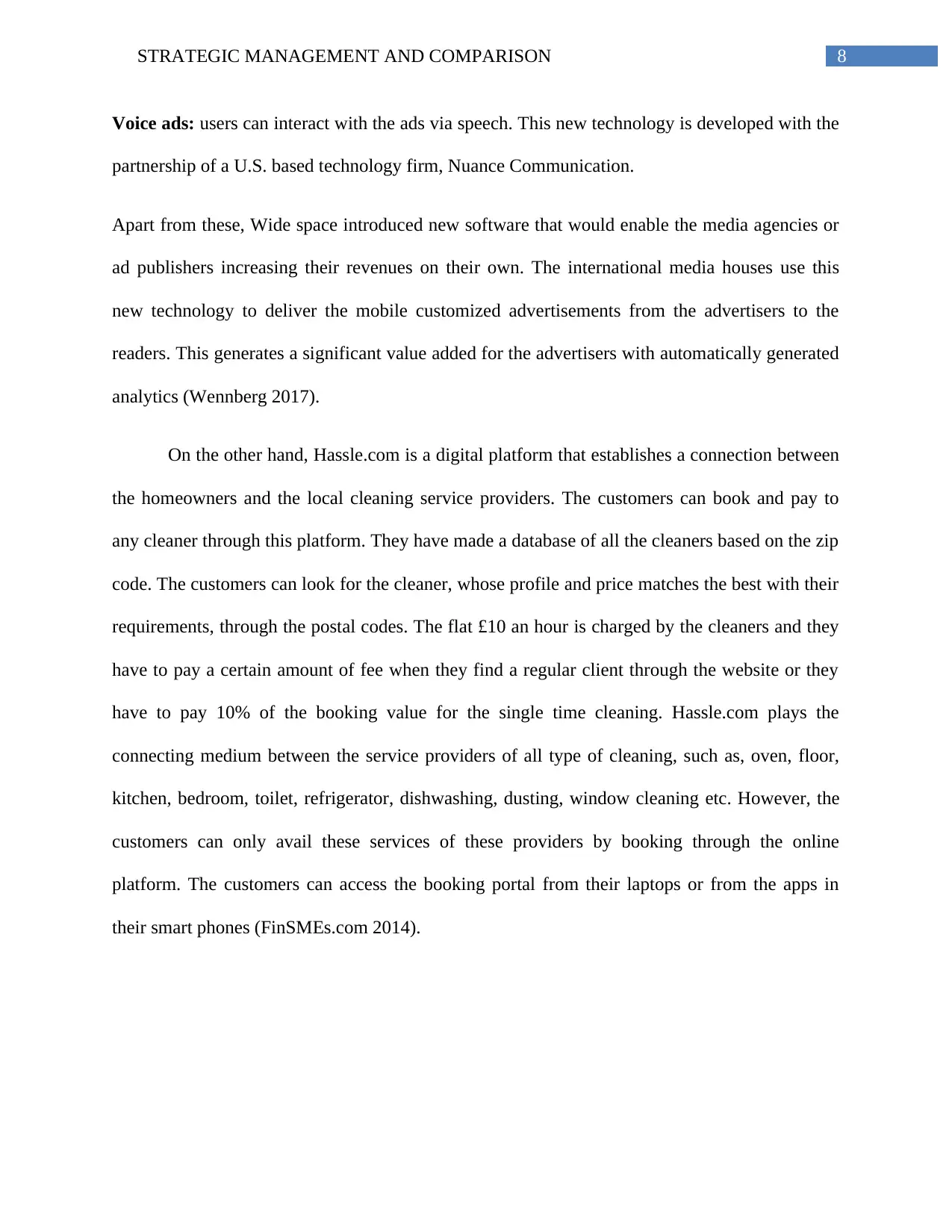
8STRATEGIC MANAGEMENT AND COMPARISON
Voice ads: users can interact with the ads via speech. This new technology is developed with the
partnership of a U.S. based technology firm, Nuance Communication.
Apart from these, Wide space introduced new software that would enable the media agencies or
ad publishers increasing their revenues on their own. The international media houses use this
new technology to deliver the mobile customized advertisements from the advertisers to the
readers. This generates a significant value added for the advertisers with automatically generated
analytics (Wennberg 2017).
On the other hand, Hassle.com is a digital platform that establishes a connection between
the homeowners and the local cleaning service providers. The customers can book and pay to
any cleaner through this platform. They have made a database of all the cleaners based on the zip
code. The customers can look for the cleaner, whose profile and price matches the best with their
requirements, through the postal codes. The flat £10 an hour is charged by the cleaners and they
have to pay a certain amount of fee when they find a regular client through the website or they
have to pay 10% of the booking value for the single time cleaning. Hassle.com plays the
connecting medium between the service providers of all type of cleaning, such as, oven, floor,
kitchen, bedroom, toilet, refrigerator, dishwashing, dusting, window cleaning etc. However, the
customers can only avail these services of these providers by booking through the online
platform. The customers can access the booking portal from their laptops or from the apps in
their smart phones (FinSMEs.com 2014).
Voice ads: users can interact with the ads via speech. This new technology is developed with the
partnership of a U.S. based technology firm, Nuance Communication.
Apart from these, Wide space introduced new software that would enable the media agencies or
ad publishers increasing their revenues on their own. The international media houses use this
new technology to deliver the mobile customized advertisements from the advertisers to the
readers. This generates a significant value added for the advertisers with automatically generated
analytics (Wennberg 2017).
On the other hand, Hassle.com is a digital platform that establishes a connection between
the homeowners and the local cleaning service providers. The customers can book and pay to
any cleaner through this platform. They have made a database of all the cleaners based on the zip
code. The customers can look for the cleaner, whose profile and price matches the best with their
requirements, through the postal codes. The flat £10 an hour is charged by the cleaners and they
have to pay a certain amount of fee when they find a regular client through the website or they
have to pay 10% of the booking value for the single time cleaning. Hassle.com plays the
connecting medium between the service providers of all type of cleaning, such as, oven, floor,
kitchen, bedroom, toilet, refrigerator, dishwashing, dusting, window cleaning etc. However, the
customers can only avail these services of these providers by booking through the online
platform. The customers can access the booking portal from their laptops or from the apps in
their smart phones (FinSMEs.com 2014).
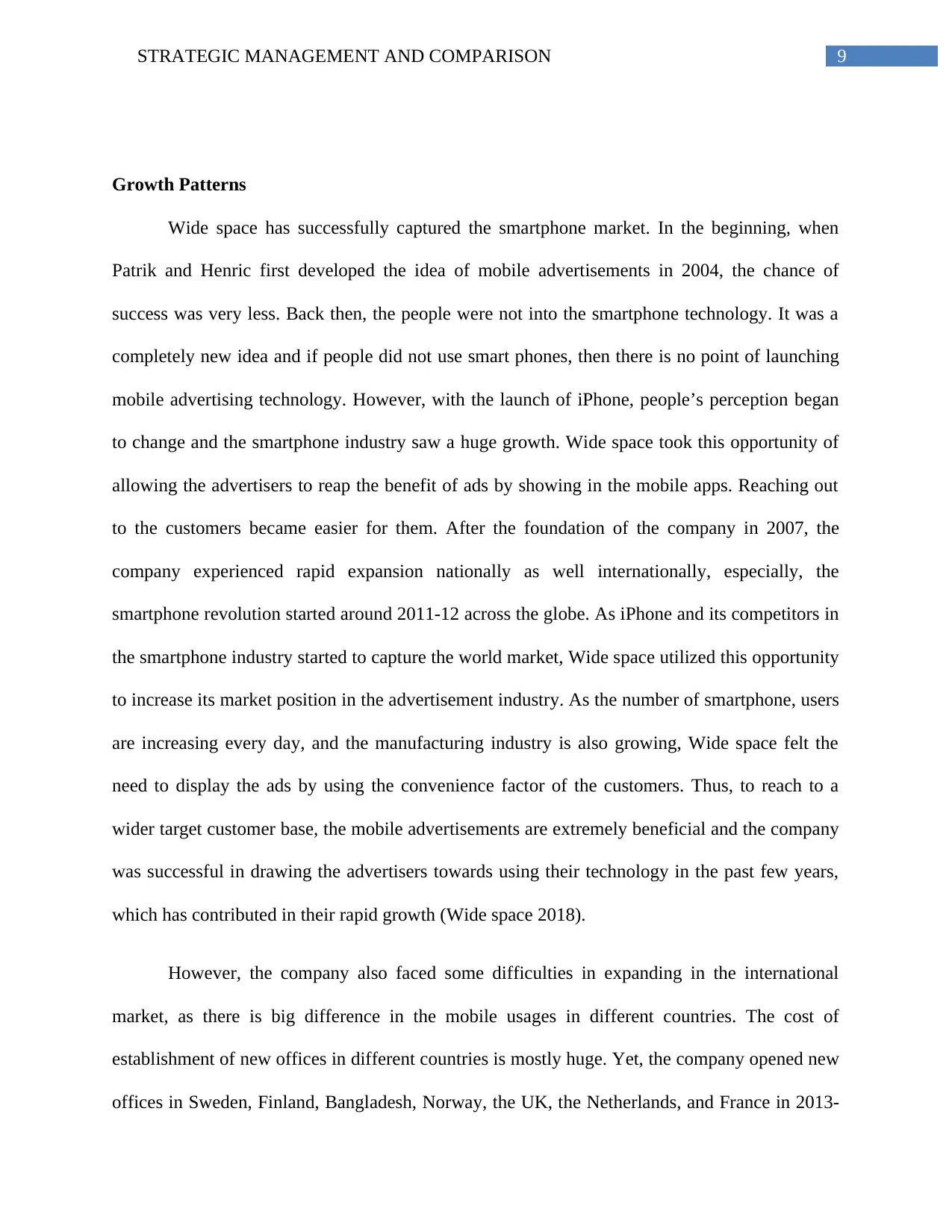
9STRATEGIC MANAGEMENT AND COMPARISON
Growth Patterns
Wide space has successfully captured the smartphone market. In the beginning, when
Patrik and Henric first developed the idea of mobile advertisements in 2004, the chance of
success was very less. Back then, the people were not into the smartphone technology. It was a
completely new idea and if people did not use smart phones, then there is no point of launching
mobile advertising technology. However, with the launch of iPhone, people’s perception began
to change and the smartphone industry saw a huge growth. Wide space took this opportunity of
allowing the advertisers to reap the benefit of ads by showing in the mobile apps. Reaching out
to the customers became easier for them. After the foundation of the company in 2007, the
company experienced rapid expansion nationally as well internationally, especially, the
smartphone revolution started around 2011-12 across the globe. As iPhone and its competitors in
the smartphone industry started to capture the world market, Wide space utilized this opportunity
to increase its market position in the advertisement industry. As the number of smartphone, users
are increasing every day, and the manufacturing industry is also growing, Wide space felt the
need to display the ads by using the convenience factor of the customers. Thus, to reach to a
wider target customer base, the mobile advertisements are extremely beneficial and the company
was successful in drawing the advertisers towards using their technology in the past few years,
which has contributed in their rapid growth (Wide space 2018).
However, the company also faced some difficulties in expanding in the international
market, as there is big difference in the mobile usages in different countries. The cost of
establishment of new offices in different countries is mostly huge. Yet, the company opened new
offices in Sweden, Finland, Bangladesh, Norway, the UK, the Netherlands, and France in 2013-
Growth Patterns
Wide space has successfully captured the smartphone market. In the beginning, when
Patrik and Henric first developed the idea of mobile advertisements in 2004, the chance of
success was very less. Back then, the people were not into the smartphone technology. It was a
completely new idea and if people did not use smart phones, then there is no point of launching
mobile advertising technology. However, with the launch of iPhone, people’s perception began
to change and the smartphone industry saw a huge growth. Wide space took this opportunity of
allowing the advertisers to reap the benefit of ads by showing in the mobile apps. Reaching out
to the customers became easier for them. After the foundation of the company in 2007, the
company experienced rapid expansion nationally as well internationally, especially, the
smartphone revolution started around 2011-12 across the globe. As iPhone and its competitors in
the smartphone industry started to capture the world market, Wide space utilized this opportunity
to increase its market position in the advertisement industry. As the number of smartphone, users
are increasing every day, and the manufacturing industry is also growing, Wide space felt the
need to display the ads by using the convenience factor of the customers. Thus, to reach to a
wider target customer base, the mobile advertisements are extremely beneficial and the company
was successful in drawing the advertisers towards using their technology in the past few years,
which has contributed in their rapid growth (Wide space 2018).
However, the company also faced some difficulties in expanding in the international
market, as there is big difference in the mobile usages in different countries. The cost of
establishment of new offices in different countries is mostly huge. Yet, the company opened new
offices in Sweden, Finland, Bangladesh, Norway, the UK, the Netherlands, and France in 2013-
Secure Best Marks with AI Grader
Need help grading? Try our AI Grader for instant feedback on your assignments.
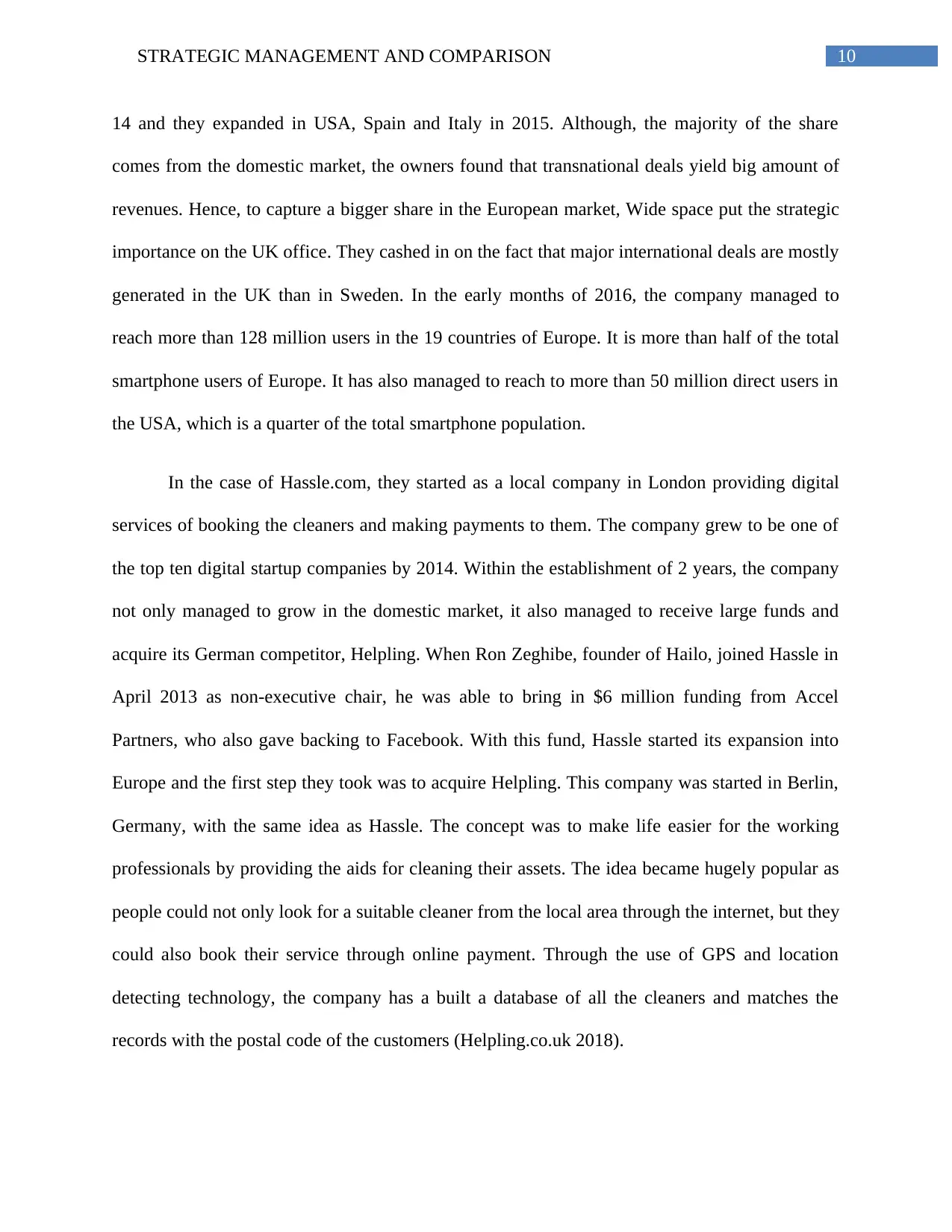
10STRATEGIC MANAGEMENT AND COMPARISON
14 and they expanded in USA, Spain and Italy in 2015. Although, the majority of the share
comes from the domestic market, the owners found that transnational deals yield big amount of
revenues. Hence, to capture a bigger share in the European market, Wide space put the strategic
importance on the UK office. They cashed in on the fact that major international deals are mostly
generated in the UK than in Sweden. In the early months of 2016, the company managed to
reach more than 128 million users in the 19 countries of Europe. It is more than half of the total
smartphone users of Europe. It has also managed to reach to more than 50 million direct users in
the USA, which is a quarter of the total smartphone population.
In the case of Hassle.com, they started as a local company in London providing digital
services of booking the cleaners and making payments to them. The company grew to be one of
the top ten digital startup companies by 2014. Within the establishment of 2 years, the company
not only managed to grow in the domestic market, it also managed to receive large funds and
acquire its German competitor, Helpling. When Ron Zeghibe, founder of Hailo, joined Hassle in
April 2013 as non-executive chair, he was able to bring in $6 million funding from Accel
Partners, who also gave backing to Facebook. With this fund, Hassle started its expansion into
Europe and the first step they took was to acquire Helpling. This company was started in Berlin,
Germany, with the same idea as Hassle. The concept was to make life easier for the working
professionals by providing the aids for cleaning their assets. The idea became hugely popular as
people could not only look for a suitable cleaner from the local area through the internet, but they
could also book their service through online payment. Through the use of GPS and location
detecting technology, the company has a built a database of all the cleaners and matches the
records with the postal code of the customers (Helpling.co.uk 2018).
14 and they expanded in USA, Spain and Italy in 2015. Although, the majority of the share
comes from the domestic market, the owners found that transnational deals yield big amount of
revenues. Hence, to capture a bigger share in the European market, Wide space put the strategic
importance on the UK office. They cashed in on the fact that major international deals are mostly
generated in the UK than in Sweden. In the early months of 2016, the company managed to
reach more than 128 million users in the 19 countries of Europe. It is more than half of the total
smartphone users of Europe. It has also managed to reach to more than 50 million direct users in
the USA, which is a quarter of the total smartphone population.
In the case of Hassle.com, they started as a local company in London providing digital
services of booking the cleaners and making payments to them. The company grew to be one of
the top ten digital startup companies by 2014. Within the establishment of 2 years, the company
not only managed to grow in the domestic market, it also managed to receive large funds and
acquire its German competitor, Helpling. When Ron Zeghibe, founder of Hailo, joined Hassle in
April 2013 as non-executive chair, he was able to bring in $6 million funding from Accel
Partners, who also gave backing to Facebook. With this fund, Hassle started its expansion into
Europe and the first step they took was to acquire Helpling. This company was started in Berlin,
Germany, with the same idea as Hassle. The concept was to make life easier for the working
professionals by providing the aids for cleaning their assets. The idea became hugely popular as
people could not only look for a suitable cleaner from the local area through the internet, but they
could also book their service through online payment. Through the use of GPS and location
detecting technology, the company has a built a database of all the cleaners and matches the
records with the postal code of the customers (Helpling.co.uk 2018).

11STRATEGIC MANAGEMENT AND COMPARISON
Helpling already started to expand its business nationally and internationally. It has offices in
major countries in Europe, such as, France, Netherlands, Italy and Ireland apart from major cities
in Germany. Outside Europe, Helping has set its offices in UAE, Australia and Singapore. When
Hassle acquired Helping in 2015, it expanded its business in the UK. In the major cities like,
Birmingham, Bristol, Manchester, Leeds, Liverpool, Cardiff and many more places, the
company has opened its offices. Thus, using a new concept the company has become to be one
of the top digital startup in just 2 years of its founding (Prassl and Risak 2015).
Generic and Developmental Strategies
Business model of Hassle.com
Hassle.com is basically provides their services through internet. This is due to the fact
that, they use their online platforms to connect the customers with the best cleaners in the town.
Thus, their service is internet based. Thus, the business model being followed by them is the
direct sales model (Stone and Woodcock 2014). However, direct sales refer to door-to-door
selling and selling by telephone without the presence of any intermediary or intermediaries, but
in the current business scenario, internet helps the business organizations to cater to the target
customers directly without the assistance of any agencies or intermediaries (Urde, Baumgarth
and Merrilees 2013). Thus, in the case of the Hassle.com, they use the medium of internet to
directly cater to the customers, which in turn helps them to reduce the cost incurred for the
intermediaries. With the help of the direct selling business model, they are enabling the
customers to choose from the wide array of services being offered from their online portal. Thus,
much like the approach of the direct selling, customers and the service providers are indulging in
one to one connections.
Helpling already started to expand its business nationally and internationally. It has offices in
major countries in Europe, such as, France, Netherlands, Italy and Ireland apart from major cities
in Germany. Outside Europe, Helping has set its offices in UAE, Australia and Singapore. When
Hassle acquired Helping in 2015, it expanded its business in the UK. In the major cities like,
Birmingham, Bristol, Manchester, Leeds, Liverpool, Cardiff and many more places, the
company has opened its offices. Thus, using a new concept the company has become to be one
of the top digital startup in just 2 years of its founding (Prassl and Risak 2015).
Generic and Developmental Strategies
Business model of Hassle.com
Hassle.com is basically provides their services through internet. This is due to the fact
that, they use their online platforms to connect the customers with the best cleaners in the town.
Thus, their service is internet based. Thus, the business model being followed by them is the
direct sales model (Stone and Woodcock 2014). However, direct sales refer to door-to-door
selling and selling by telephone without the presence of any intermediary or intermediaries, but
in the current business scenario, internet helps the business organizations to cater to the target
customers directly without the assistance of any agencies or intermediaries (Urde, Baumgarth
and Merrilees 2013). Thus, in the case of the Hassle.com, they use the medium of internet to
directly cater to the customers, which in turn helps them to reduce the cost incurred for the
intermediaries. With the help of the direct selling business model, they are enabling the
customers to choose from the wide array of services being offered from their online portal. Thus,
much like the approach of the direct selling, customers and the service providers are indulging in
one to one connections.
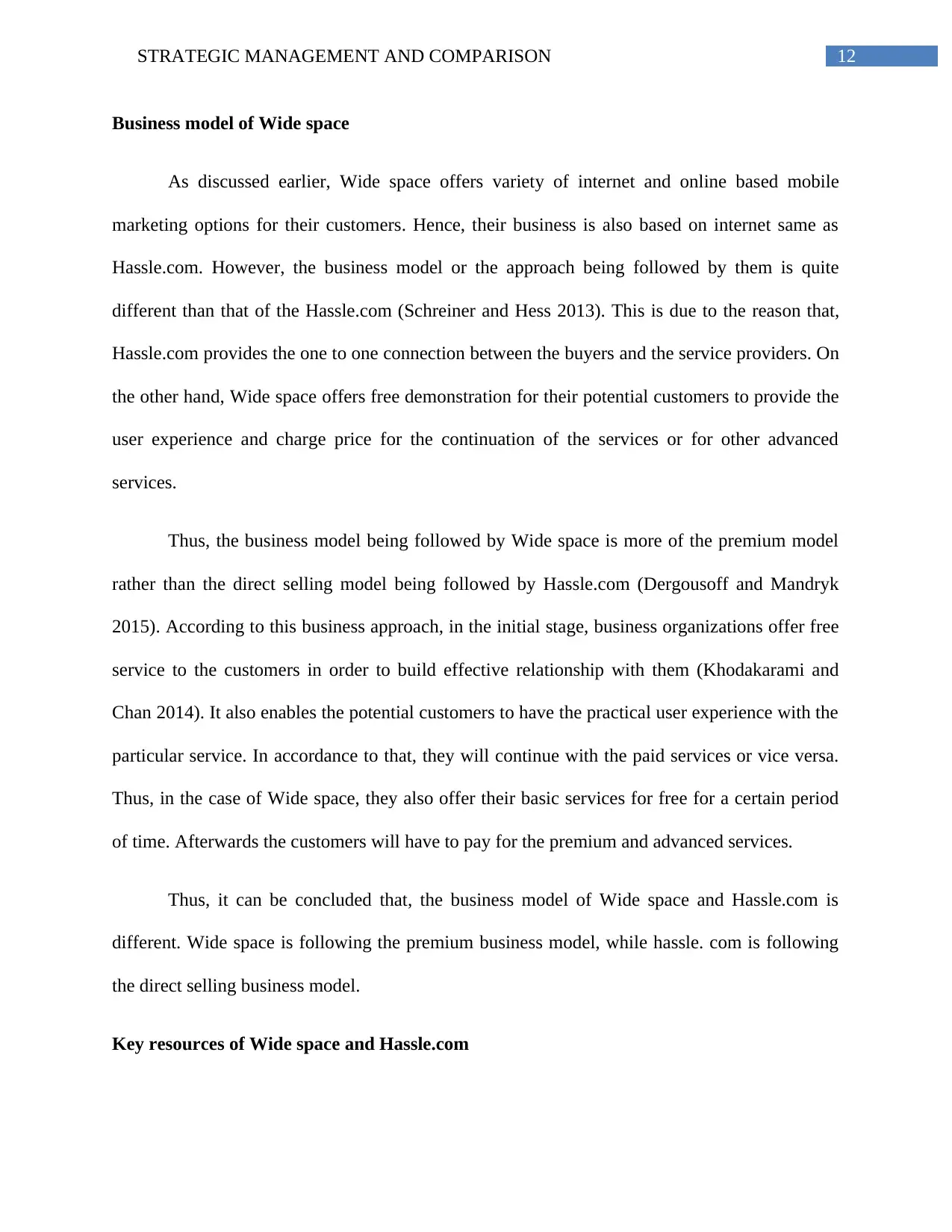
12STRATEGIC MANAGEMENT AND COMPARISON
Business model of Wide space
As discussed earlier, Wide space offers variety of internet and online based mobile
marketing options for their customers. Hence, their business is also based on internet same as
Hassle.com. However, the business model or the approach being followed by them is quite
different than that of the Hassle.com (Schreiner and Hess 2013). This is due to the reason that,
Hassle.com provides the one to one connection between the buyers and the service providers. On
the other hand, Wide space offers free demonstration for their potential customers to provide the
user experience and charge price for the continuation of the services or for other advanced
services.
Thus, the business model being followed by Wide space is more of the premium model
rather than the direct selling model being followed by Hassle.com (Dergousoff and Mandryk
2015). According to this business approach, in the initial stage, business organizations offer free
service to the customers in order to build effective relationship with them (Khodakarami and
Chan 2014). It also enables the potential customers to have the practical user experience with the
particular service. In accordance to that, they will continue with the paid services or vice versa.
Thus, in the case of Wide space, they also offer their basic services for free for a certain period
of time. Afterwards the customers will have to pay for the premium and advanced services.
Thus, it can be concluded that, the business model of Wide space and Hassle.com is
different. Wide space is following the premium business model, while hassle. com is following
the direct selling business model.
Key resources of Wide space and Hassle.com
Business model of Wide space
As discussed earlier, Wide space offers variety of internet and online based mobile
marketing options for their customers. Hence, their business is also based on internet same as
Hassle.com. However, the business model or the approach being followed by them is quite
different than that of the Hassle.com (Schreiner and Hess 2013). This is due to the reason that,
Hassle.com provides the one to one connection between the buyers and the service providers. On
the other hand, Wide space offers free demonstration for their potential customers to provide the
user experience and charge price for the continuation of the services or for other advanced
services.
Thus, the business model being followed by Wide space is more of the premium model
rather than the direct selling model being followed by Hassle.com (Dergousoff and Mandryk
2015). According to this business approach, in the initial stage, business organizations offer free
service to the customers in order to build effective relationship with them (Khodakarami and
Chan 2014). It also enables the potential customers to have the practical user experience with the
particular service. In accordance to that, they will continue with the paid services or vice versa.
Thus, in the case of Wide space, they also offer their basic services for free for a certain period
of time. Afterwards the customers will have to pay for the premium and advanced services.
Thus, it can be concluded that, the business model of Wide space and Hassle.com is
different. Wide space is following the premium business model, while hassle. com is following
the direct selling business model.
Key resources of Wide space and Hassle.com
Paraphrase This Document
Need a fresh take? Get an instant paraphrase of this document with our AI Paraphraser
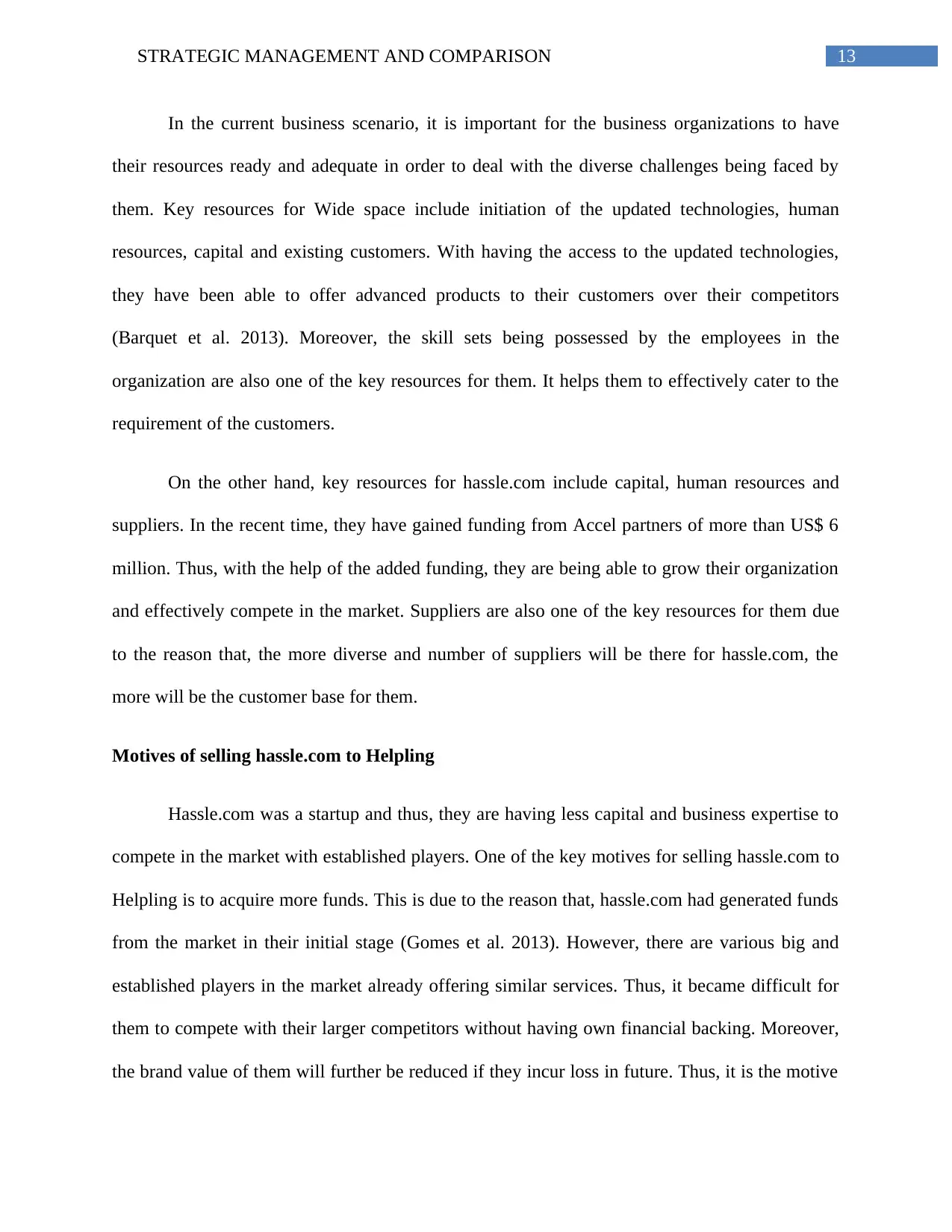
13STRATEGIC MANAGEMENT AND COMPARISON
In the current business scenario, it is important for the business organizations to have
their resources ready and adequate in order to deal with the diverse challenges being faced by
them. Key resources for Wide space include initiation of the updated technologies, human
resources, capital and existing customers. With having the access to the updated technologies,
they have been able to offer advanced products to their customers over their competitors
(Barquet et al. 2013). Moreover, the skill sets being possessed by the employees in the
organization are also one of the key resources for them. It helps them to effectively cater to the
requirement of the customers.
On the other hand, key resources for hassle.com include capital, human resources and
suppliers. In the recent time, they have gained funding from Accel partners of more than US$ 6
million. Thus, with the help of the added funding, they are being able to grow their organization
and effectively compete in the market. Suppliers are also one of the key resources for them due
to the reason that, the more diverse and number of suppliers will be there for hassle.com, the
more will be the customer base for them.
Motives of selling hassle.com to Helpling
Hassle.com was a startup and thus, they are having less capital and business expertise to
compete in the market with established players. One of the key motives for selling hassle.com to
Helpling is to acquire more funds. This is due to the reason that, hassle.com had generated funds
from the market in their initial stage (Gomes et al. 2013). However, there are various big and
established players in the market already offering similar services. Thus, it became difficult for
them to compete with their larger competitors without having own financial backing. Moreover,
the brand value of them will further be reduced if they incur loss in future. Thus, it is the motive
In the current business scenario, it is important for the business organizations to have
their resources ready and adequate in order to deal with the diverse challenges being faced by
them. Key resources for Wide space include initiation of the updated technologies, human
resources, capital and existing customers. With having the access to the updated technologies,
they have been able to offer advanced products to their customers over their competitors
(Barquet et al. 2013). Moreover, the skill sets being possessed by the employees in the
organization are also one of the key resources for them. It helps them to effectively cater to the
requirement of the customers.
On the other hand, key resources for hassle.com include capital, human resources and
suppliers. In the recent time, they have gained funding from Accel partners of more than US$ 6
million. Thus, with the help of the added funding, they are being able to grow their organization
and effectively compete in the market. Suppliers are also one of the key resources for them due
to the reason that, the more diverse and number of suppliers will be there for hassle.com, the
more will be the customer base for them.
Motives of selling hassle.com to Helpling
Hassle.com was a startup and thus, they are having less capital and business expertise to
compete in the market with established players. One of the key motives for selling hassle.com to
Helpling is to acquire more funds. This is due to the reason that, hassle.com had generated funds
from the market in their initial stage (Gomes et al. 2013). However, there are various big and
established players in the market already offering similar services. Thus, it became difficult for
them to compete with their larger competitors without having own financial backing. Moreover,
the brand value of them will further be reduced if they incur loss in future. Thus, it is the motive
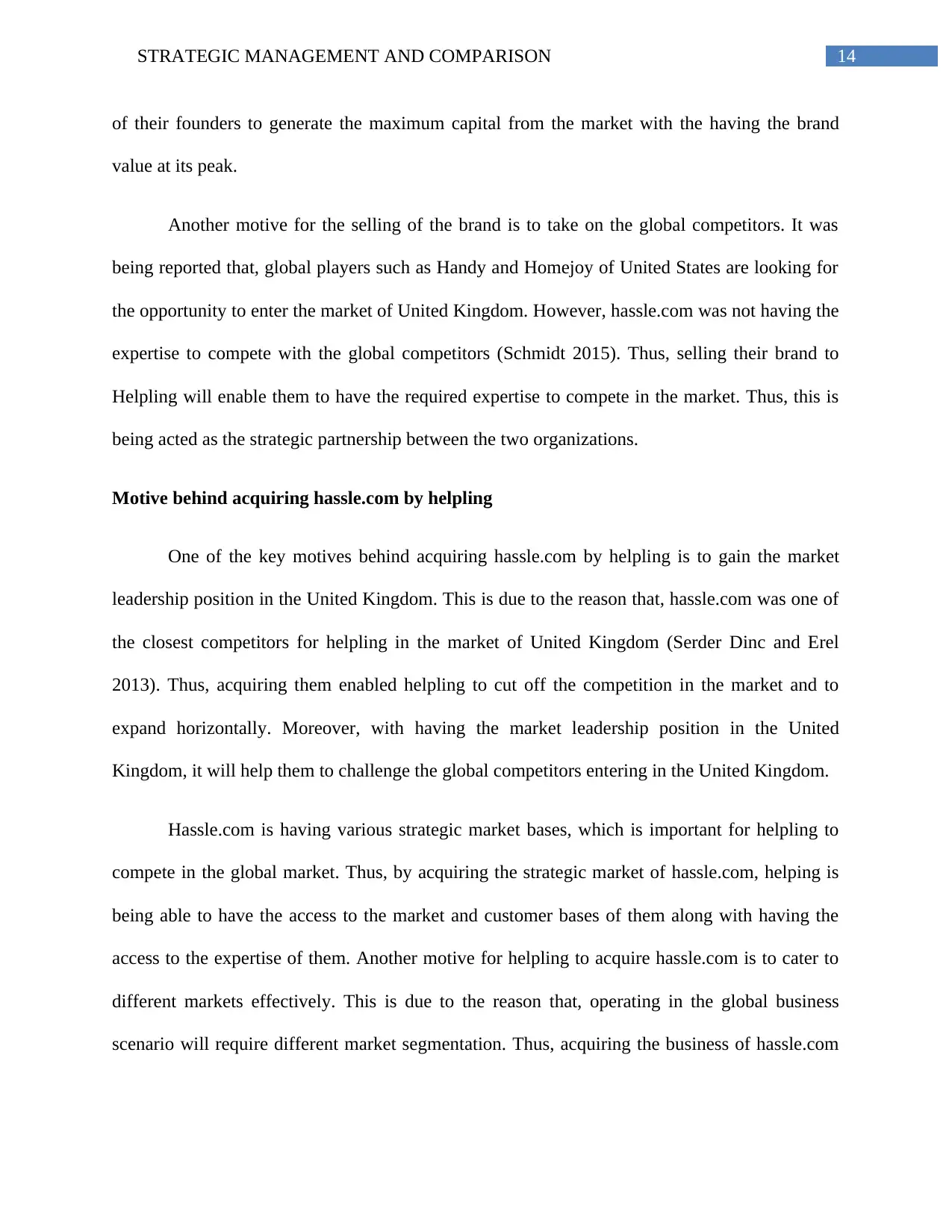
14STRATEGIC MANAGEMENT AND COMPARISON
of their founders to generate the maximum capital from the market with the having the brand
value at its peak.
Another motive for the selling of the brand is to take on the global competitors. It was
being reported that, global players such as Handy and Homejoy of United States are looking for
the opportunity to enter the market of United Kingdom. However, hassle.com was not having the
expertise to compete with the global competitors (Schmidt 2015). Thus, selling their brand to
Helpling will enable them to have the required expertise to compete in the market. Thus, this is
being acted as the strategic partnership between the two organizations.
Motive behind acquiring hassle.com by helpling
One of the key motives behind acquiring hassle.com by helpling is to gain the market
leadership position in the United Kingdom. This is due to the reason that, hassle.com was one of
the closest competitors for helpling in the market of United Kingdom (Serder Dinc and Erel
2013). Thus, acquiring them enabled helpling to cut off the competition in the market and to
expand horizontally. Moreover, with having the market leadership position in the United
Kingdom, it will help them to challenge the global competitors entering in the United Kingdom.
Hassle.com is having various strategic market bases, which is important for helpling to
compete in the global market. Thus, by acquiring the strategic market of hassle.com, helping is
being able to have the access to the market and customer bases of them along with having the
access to the expertise of them. Another motive for helpling to acquire hassle.com is to cater to
different markets effectively. This is due to the reason that, operating in the global business
scenario will require different market segmentation. Thus, acquiring the business of hassle.com
of their founders to generate the maximum capital from the market with the having the brand
value at its peak.
Another motive for the selling of the brand is to take on the global competitors. It was
being reported that, global players such as Handy and Homejoy of United States are looking for
the opportunity to enter the market of United Kingdom. However, hassle.com was not having the
expertise to compete with the global competitors (Schmidt 2015). Thus, selling their brand to
Helpling will enable them to have the required expertise to compete in the market. Thus, this is
being acted as the strategic partnership between the two organizations.
Motive behind acquiring hassle.com by helpling
One of the key motives behind acquiring hassle.com by helpling is to gain the market
leadership position in the United Kingdom. This is due to the reason that, hassle.com was one of
the closest competitors for helpling in the market of United Kingdom (Serder Dinc and Erel
2013). Thus, acquiring them enabled helpling to cut off the competition in the market and to
expand horizontally. Moreover, with having the market leadership position in the United
Kingdom, it will help them to challenge the global competitors entering in the United Kingdom.
Hassle.com is having various strategic market bases, which is important for helpling to
compete in the global market. Thus, by acquiring the strategic market of hassle.com, helping is
being able to have the access to the market and customer bases of them along with having the
access to the expertise of them. Another motive for helpling to acquire hassle.com is to cater to
different markets effectively. This is due to the reason that, operating in the global business
scenario will require different market segmentation. Thus, acquiring the business of hassle.com
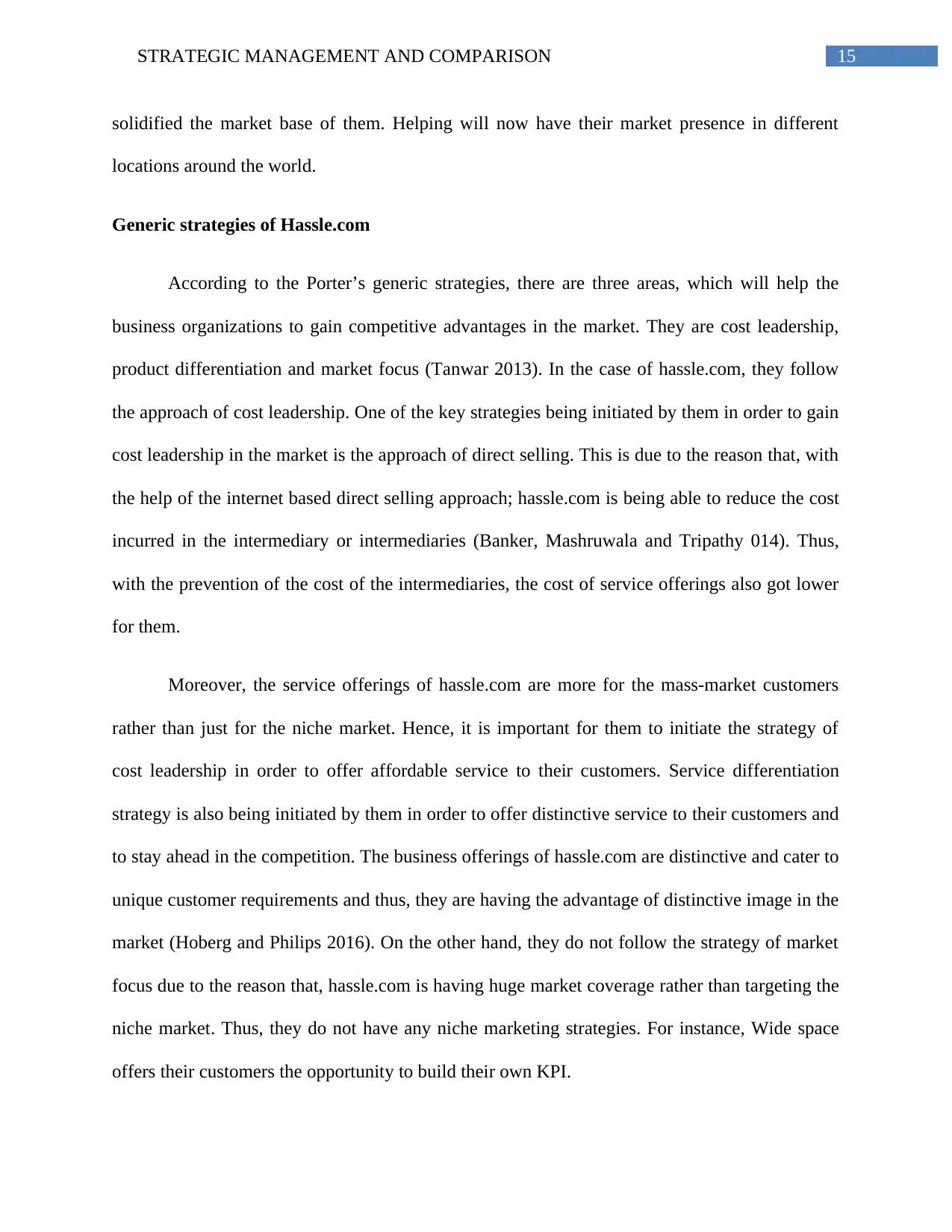
15STRATEGIC MANAGEMENT AND COMPARISON
solidified the market base of them. Helping will now have their market presence in different
locations around the world.
Generic strategies of Hassle.com
According to the Porter’s generic strategies, there are three areas, which will help the
business organizations to gain competitive advantages in the market. They are cost leadership,
product differentiation and market focus (Tanwar 2013). In the case of hassle.com, they follow
the approach of cost leadership. One of the key strategies being initiated by them in order to gain
cost leadership in the market is the approach of direct selling. This is due to the reason that, with
the help of the internet based direct selling approach; hassle.com is being able to reduce the cost
incurred in the intermediary or intermediaries (Banker, Mashruwala and Tripathy 014). Thus,
with the prevention of the cost of the intermediaries, the cost of service offerings also got lower
for them.
Moreover, the service offerings of hassle.com are more for the mass-market customers
rather than just for the niche market. Hence, it is important for them to initiate the strategy of
cost leadership in order to offer affordable service to their customers. Service differentiation
strategy is also being initiated by them in order to offer distinctive service to their customers and
to stay ahead in the competition. The business offerings of hassle.com are distinctive and cater to
unique customer requirements and thus, they are having the advantage of distinctive image in the
market (Hoberg and Philips 2016). On the other hand, they do not follow the strategy of market
focus due to the reason that, hassle.com is having huge market coverage rather than targeting the
niche market. Thus, they do not have any niche marketing strategies. For instance, Wide space
offers their customers the opportunity to build their own KPI.
solidified the market base of them. Helping will now have their market presence in different
locations around the world.
Generic strategies of Hassle.com
According to the Porter’s generic strategies, there are three areas, which will help the
business organizations to gain competitive advantages in the market. They are cost leadership,
product differentiation and market focus (Tanwar 2013). In the case of hassle.com, they follow
the approach of cost leadership. One of the key strategies being initiated by them in order to gain
cost leadership in the market is the approach of direct selling. This is due to the reason that, with
the help of the internet based direct selling approach; hassle.com is being able to reduce the cost
incurred in the intermediary or intermediaries (Banker, Mashruwala and Tripathy 014). Thus,
with the prevention of the cost of the intermediaries, the cost of service offerings also got lower
for them.
Moreover, the service offerings of hassle.com are more for the mass-market customers
rather than just for the niche market. Hence, it is important for them to initiate the strategy of
cost leadership in order to offer affordable service to their customers. Service differentiation
strategy is also being initiated by them in order to offer distinctive service to their customers and
to stay ahead in the competition. The business offerings of hassle.com are distinctive and cater to
unique customer requirements and thus, they are having the advantage of distinctive image in the
market (Hoberg and Philips 2016). On the other hand, they do not follow the strategy of market
focus due to the reason that, hassle.com is having huge market coverage rather than targeting the
niche market. Thus, they do not have any niche marketing strategies. For instance, Wide space
offers their customers the opportunity to build their own KPI.
Secure Best Marks with AI Grader
Need help grading? Try our AI Grader for instant feedback on your assignments.
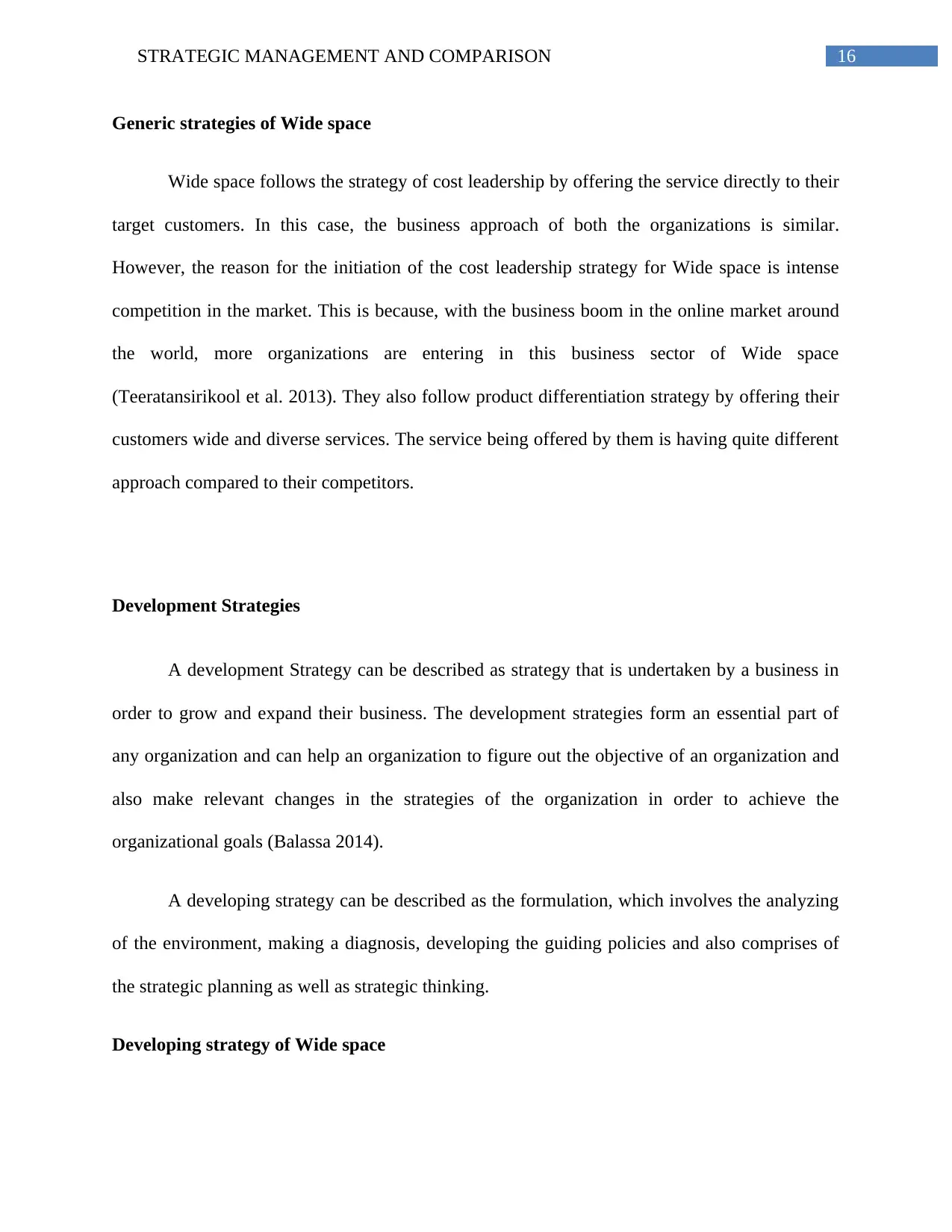
16STRATEGIC MANAGEMENT AND COMPARISON
Generic strategies of Wide space
Wide space follows the strategy of cost leadership by offering the service directly to their
target customers. In this case, the business approach of both the organizations is similar.
However, the reason for the initiation of the cost leadership strategy for Wide space is intense
competition in the market. This is because, with the business boom in the online market around
the world, more organizations are entering in this business sector of Wide space
(Teeratansirikool et al. 2013). They also follow product differentiation strategy by offering their
customers wide and diverse services. The service being offered by them is having quite different
approach compared to their competitors.
Development Strategies
A development Strategy can be described as strategy that is undertaken by a business in
order to grow and expand their business. The development strategies form an essential part of
any organization and can help an organization to figure out the objective of an organization and
also make relevant changes in the strategies of the organization in order to achieve the
organizational goals (Balassa 2014).
A developing strategy can be described as the formulation, which involves the analyzing
of the environment, making a diagnosis, developing the guiding policies and also comprises of
the strategic planning as well as strategic thinking.
Developing strategy of Wide space
Generic strategies of Wide space
Wide space follows the strategy of cost leadership by offering the service directly to their
target customers. In this case, the business approach of both the organizations is similar.
However, the reason for the initiation of the cost leadership strategy for Wide space is intense
competition in the market. This is because, with the business boom in the online market around
the world, more organizations are entering in this business sector of Wide space
(Teeratansirikool et al. 2013). They also follow product differentiation strategy by offering their
customers wide and diverse services. The service being offered by them is having quite different
approach compared to their competitors.
Development Strategies
A development Strategy can be described as strategy that is undertaken by a business in
order to grow and expand their business. The development strategies form an essential part of
any organization and can help an organization to figure out the objective of an organization and
also make relevant changes in the strategies of the organization in order to achieve the
organizational goals (Balassa 2014).
A developing strategy can be described as the formulation, which involves the analyzing
of the environment, making a diagnosis, developing the guiding policies and also comprises of
the strategic planning as well as strategic thinking.
Developing strategy of Wide space
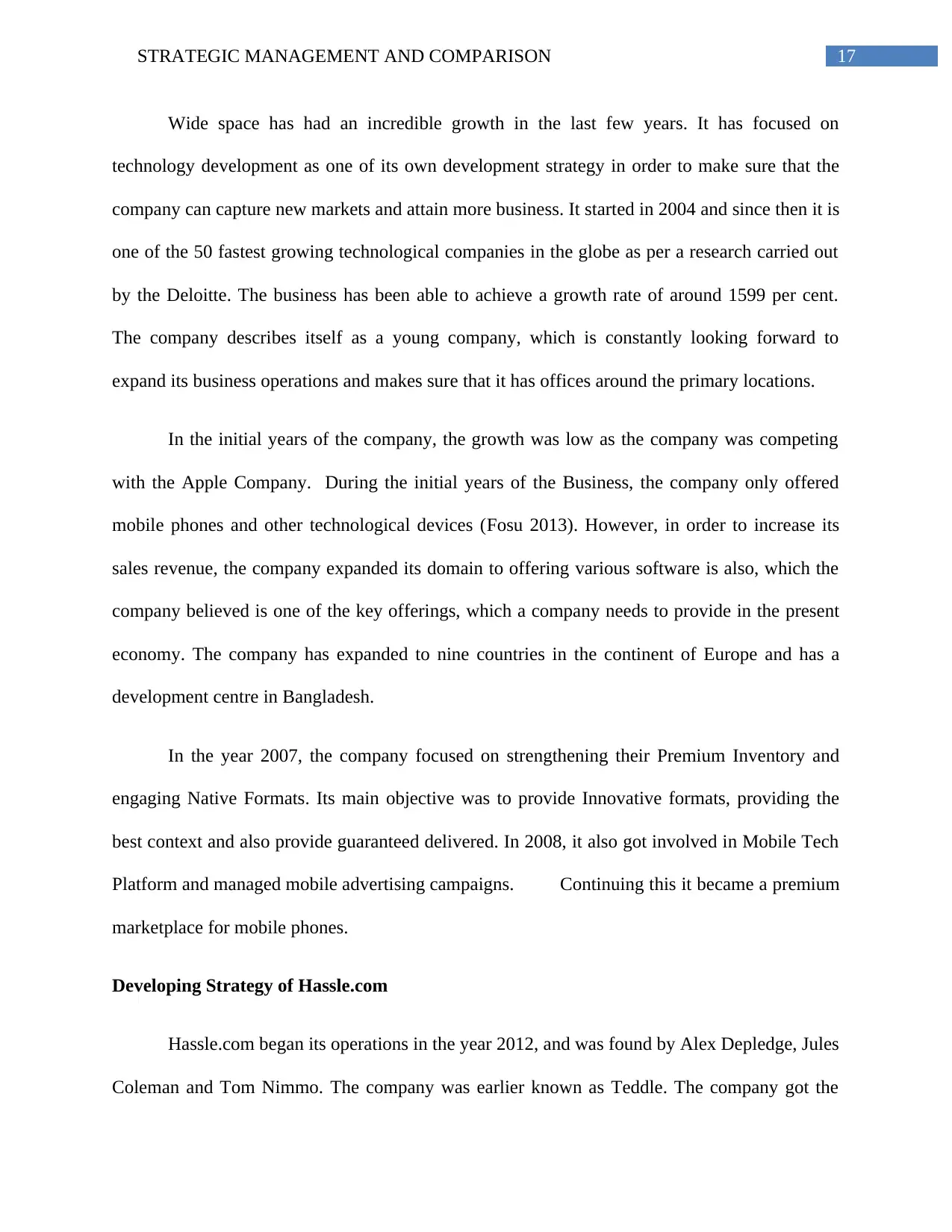
17STRATEGIC MANAGEMENT AND COMPARISON
Wide space has had an incredible growth in the last few years. It has focused on
technology development as one of its own development strategy in order to make sure that the
company can capture new markets and attain more business. It started in 2004 and since then it is
one of the 50 fastest growing technological companies in the globe as per a research carried out
by the Deloitte. The business has been able to achieve a growth rate of around 1599 per cent.
The company describes itself as a young company, which is constantly looking forward to
expand its business operations and makes sure that it has offices around the primary locations.
In the initial years of the company, the growth was low as the company was competing
with the Apple Company. During the initial years of the Business, the company only offered
mobile phones and other technological devices (Fosu 2013). However, in order to increase its
sales revenue, the company expanded its domain to offering various software is also, which the
company believed is one of the key offerings, which a company needs to provide in the present
economy. The company has expanded to nine countries in the continent of Europe and has a
development centre in Bangladesh.
In the year 2007, the company focused on strengthening their Premium Inventory and
engaging Native Formats. Its main objective was to provide Innovative formats, providing the
best context and also provide guaranteed delivered. In 2008, it also got involved in Mobile Tech
Platform and managed mobile advertising campaigns. Continuing this it became a premium
marketplace for mobile phones.
Developing Strategy of Hassle.com
Hassle.com began its operations in the year 2012, and was found by Alex Depledge, Jules
Coleman and Tom Nimmo. The company was earlier known as Teddle. The company got the
Wide space has had an incredible growth in the last few years. It has focused on
technology development as one of its own development strategy in order to make sure that the
company can capture new markets and attain more business. It started in 2004 and since then it is
one of the 50 fastest growing technological companies in the globe as per a research carried out
by the Deloitte. The business has been able to achieve a growth rate of around 1599 per cent.
The company describes itself as a young company, which is constantly looking forward to
expand its business operations and makes sure that it has offices around the primary locations.
In the initial years of the company, the growth was low as the company was competing
with the Apple Company. During the initial years of the Business, the company only offered
mobile phones and other technological devices (Fosu 2013). However, in order to increase its
sales revenue, the company expanded its domain to offering various software is also, which the
company believed is one of the key offerings, which a company needs to provide in the present
economy. The company has expanded to nine countries in the continent of Europe and has a
development centre in Bangladesh.
In the year 2007, the company focused on strengthening their Premium Inventory and
engaging Native Formats. Its main objective was to provide Innovative formats, providing the
best context and also provide guaranteed delivered. In 2008, it also got involved in Mobile Tech
Platform and managed mobile advertising campaigns. Continuing this it became a premium
marketplace for mobile phones.
Developing Strategy of Hassle.com
Hassle.com began its operations in the year 2012, and was found by Alex Depledge, Jules
Coleman and Tom Nimmo. The company was earlier known as Teddle. The company got the
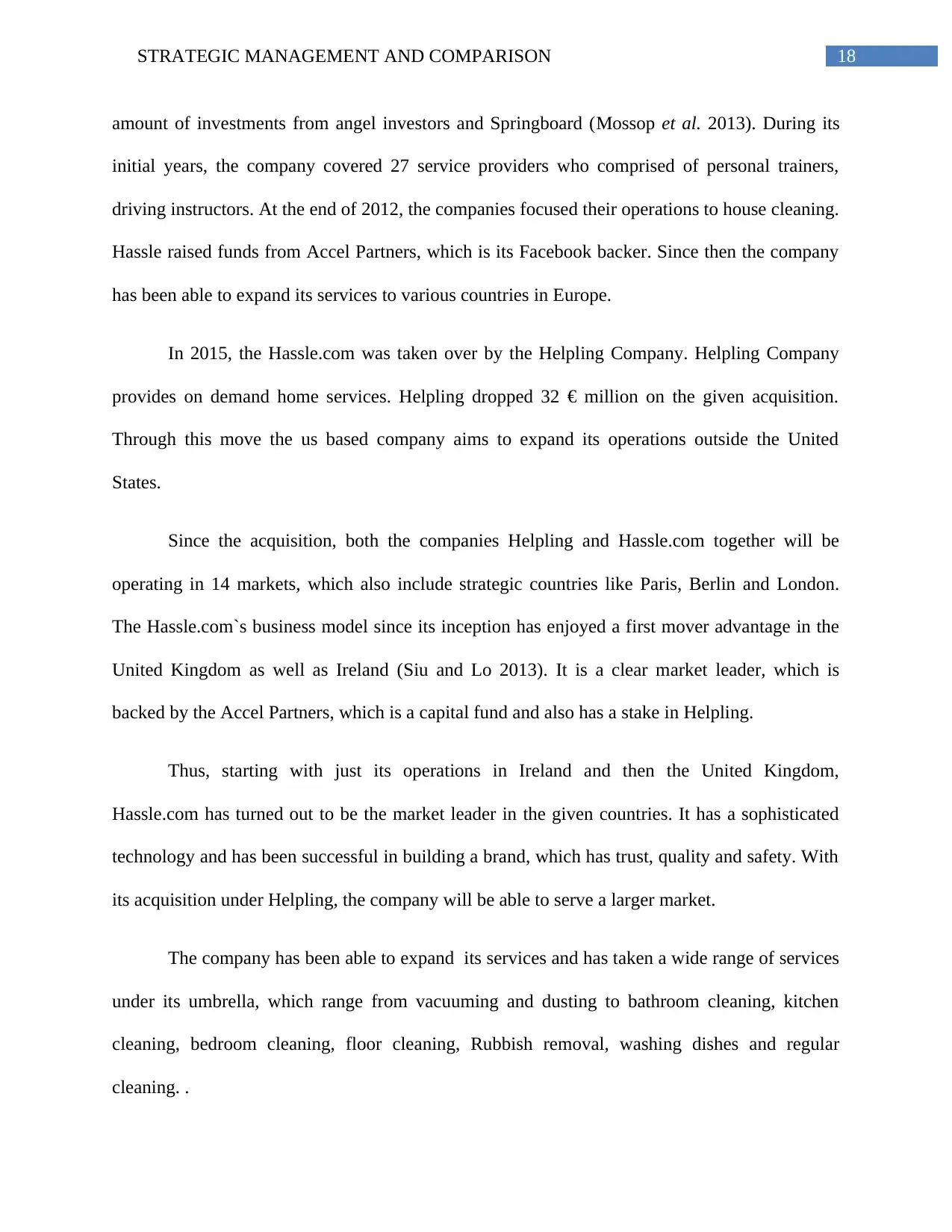
18STRATEGIC MANAGEMENT AND COMPARISON
amount of investments from angel investors and Springboard (Mossop et al. 2013). During its
initial years, the company covered 27 service providers who comprised of personal trainers,
driving instructors. At the end of 2012, the companies focused their operations to house cleaning.
Hassle raised funds from Accel Partners, which is its Facebook backer. Since then the company
has been able to expand its services to various countries in Europe.
In 2015, the Hassle.com was taken over by the Helpling Company. Helpling Company
provides on demand home services. Helpling dropped 32 € million on the given acquisition.
Through this move the us based company aims to expand its operations outside the United
States.
Since the acquisition, both the companies Helpling and Hassle.com together will be
operating in 14 markets, which also include strategic countries like Paris, Berlin and London.
The Hassle.com`s business model since its inception has enjoyed a first mover advantage in the
United Kingdom as well as Ireland (Siu and Lo 2013). It is a clear market leader, which is
backed by the Accel Partners, which is a capital fund and also has a stake in Helpling.
Thus, starting with just its operations in Ireland and then the United Kingdom,
Hassle.com has turned out to be the market leader in the given countries. It has a sophisticated
technology and has been successful in building a brand, which has trust, quality and safety. With
its acquisition under Helpling, the company will be able to serve a larger market.
The company has been able to expand its services and has taken a wide range of services
under its umbrella, which range from vacuuming and dusting to bathroom cleaning, kitchen
cleaning, bedroom cleaning, floor cleaning, Rubbish removal, washing dishes and regular
cleaning. .
amount of investments from angel investors and Springboard (Mossop et al. 2013). During its
initial years, the company covered 27 service providers who comprised of personal trainers,
driving instructors. At the end of 2012, the companies focused their operations to house cleaning.
Hassle raised funds from Accel Partners, which is its Facebook backer. Since then the company
has been able to expand its services to various countries in Europe.
In 2015, the Hassle.com was taken over by the Helpling Company. Helpling Company
provides on demand home services. Helpling dropped 32 € million on the given acquisition.
Through this move the us based company aims to expand its operations outside the United
States.
Since the acquisition, both the companies Helpling and Hassle.com together will be
operating in 14 markets, which also include strategic countries like Paris, Berlin and London.
The Hassle.com`s business model since its inception has enjoyed a first mover advantage in the
United Kingdom as well as Ireland (Siu and Lo 2013). It is a clear market leader, which is
backed by the Accel Partners, which is a capital fund and also has a stake in Helpling.
Thus, starting with just its operations in Ireland and then the United Kingdom,
Hassle.com has turned out to be the market leader in the given countries. It has a sophisticated
technology and has been successful in building a brand, which has trust, quality and safety. With
its acquisition under Helpling, the company will be able to serve a larger market.
The company has been able to expand its services and has taken a wide range of services
under its umbrella, which range from vacuuming and dusting to bathroom cleaning, kitchen
cleaning, bedroom cleaning, floor cleaning, Rubbish removal, washing dishes and regular
cleaning. .
Paraphrase This Document
Need a fresh take? Get an instant paraphrase of this document with our AI Paraphraser
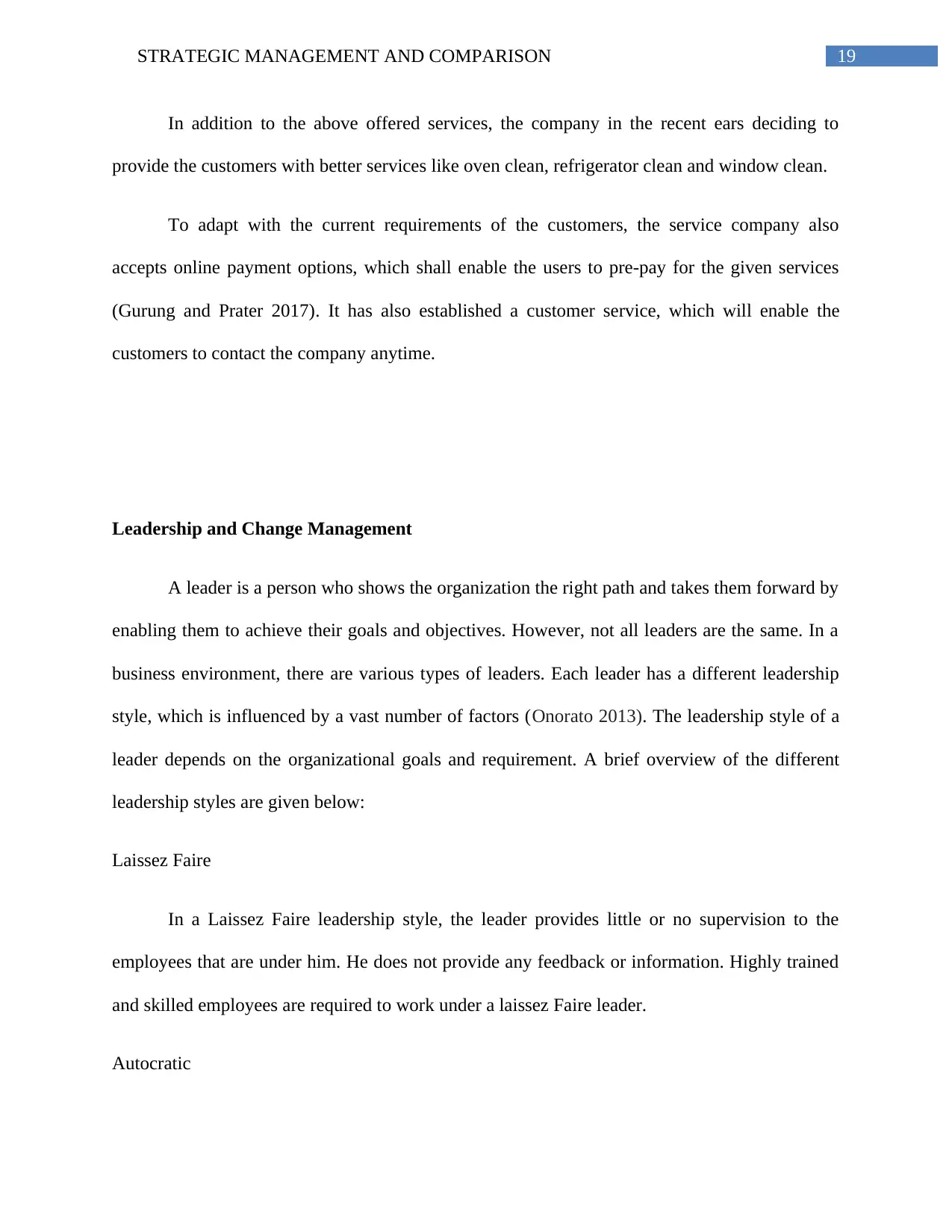
19STRATEGIC MANAGEMENT AND COMPARISON
In addition to the above offered services, the company in the recent ears deciding to
provide the customers with better services like oven clean, refrigerator clean and window clean.
To adapt with the current requirements of the customers, the service company also
accepts online payment options, which shall enable the users to pre-pay for the given services
(Gurung and Prater 2017). It has also established a customer service, which will enable the
customers to contact the company anytime.
Leadership and Change Management
A leader is a person who shows the organization the right path and takes them forward by
enabling them to achieve their goals and objectives. However, not all leaders are the same. In a
business environment, there are various types of leaders. Each leader has a different leadership
style, which is influenced by a vast number of factors (Onorato 2013). The leadership style of a
leader depends on the organizational goals and requirement. A brief overview of the different
leadership styles are given below:
Laissez Faire
In a Laissez Faire leadership style, the leader provides little or no supervision to the
employees that are under him. He does not provide any feedback or information. Highly trained
and skilled employees are required to work under a laissez Faire leader.
Autocratic
In addition to the above offered services, the company in the recent ears deciding to
provide the customers with better services like oven clean, refrigerator clean and window clean.
To adapt with the current requirements of the customers, the service company also
accepts online payment options, which shall enable the users to pre-pay for the given services
(Gurung and Prater 2017). It has also established a customer service, which will enable the
customers to contact the company anytime.
Leadership and Change Management
A leader is a person who shows the organization the right path and takes them forward by
enabling them to achieve their goals and objectives. However, not all leaders are the same. In a
business environment, there are various types of leaders. Each leader has a different leadership
style, which is influenced by a vast number of factors (Onorato 2013). The leadership style of a
leader depends on the organizational goals and requirement. A brief overview of the different
leadership styles are given below:
Laissez Faire
In a Laissez Faire leadership style, the leader provides little or no supervision to the
employees that are under him. He does not provide any feedback or information. Highly trained
and skilled employees are required to work under a laissez Faire leader.
Autocratic
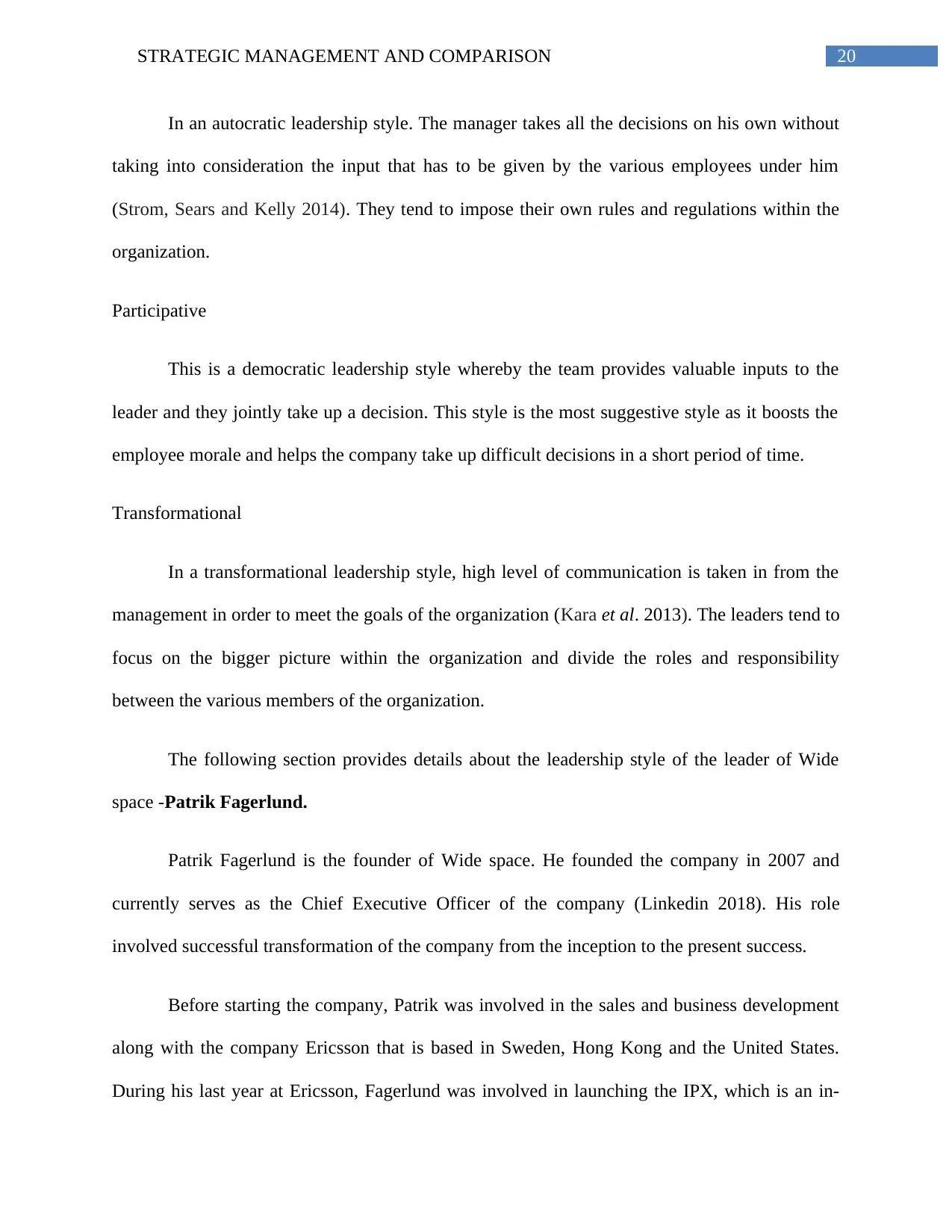
20STRATEGIC MANAGEMENT AND COMPARISON
In an autocratic leadership style. The manager takes all the decisions on his own without
taking into consideration the input that has to be given by the various employees under him
(Strom, Sears and Kelly 2014). They tend to impose their own rules and regulations within the
organization.
Participative
This is a democratic leadership style whereby the team provides valuable inputs to the
leader and they jointly take up a decision. This style is the most suggestive style as it boosts the
employee morale and helps the company take up difficult decisions in a short period of time.
Transformational
In a transformational leadership style, high level of communication is taken in from the
management in order to meet the goals of the organization (Kara et al. 2013). The leaders tend to
focus on the bigger picture within the organization and divide the roles and responsibility
between the various members of the organization.
The following section provides details about the leadership style of the leader of Wide
space -Patrik Fagerlund.
Patrik Fagerlund is the founder of Wide space. He founded the company in 2007 and
currently serves as the Chief Executive Officer of the company (Linkedin 2018). His role
involved successful transformation of the company from the inception to the present success.
Before starting the company, Patrik was involved in the sales and business development
along with the company Ericsson that is based in Sweden, Hong Kong and the United States.
During his last year at Ericsson, Fagerlund was involved in launching the IPX, which is an in-
In an autocratic leadership style. The manager takes all the decisions on his own without
taking into consideration the input that has to be given by the various employees under him
(Strom, Sears and Kelly 2014). They tend to impose their own rules and regulations within the
organization.
Participative
This is a democratic leadership style whereby the team provides valuable inputs to the
leader and they jointly take up a decision. This style is the most suggestive style as it boosts the
employee morale and helps the company take up difficult decisions in a short period of time.
Transformational
In a transformational leadership style, high level of communication is taken in from the
management in order to meet the goals of the organization (Kara et al. 2013). The leaders tend to
focus on the bigger picture within the organization and divide the roles and responsibility
between the various members of the organization.
The following section provides details about the leadership style of the leader of Wide
space -Patrik Fagerlund.
Patrik Fagerlund is the founder of Wide space. He founded the company in 2007 and
currently serves as the Chief Executive Officer of the company (Linkedin 2018). His role
involved successful transformation of the company from the inception to the present success.
Before starting the company, Patrik was involved in the sales and business development
along with the company Ericsson that is based in Sweden, Hong Kong and the United States.
During his last year at Ericsson, Fagerlund was involved in launching the IPX, which is an in-

21STRATEGIC MANAGEMENT AND COMPARISON
house funded start up with successfully growing revenue of $80 million (Men and Stacks 2013).
Patrik has over 2 decades of experience in the media, Information technology and media industry
globally.
Patrik belongs to a humble background and holds a Masters Degree from The Chalmers
University of Technology.
As stated earlier, Fagerlund already had a certain amount of experience in the field of
information technology and telecom. Hence, in the year 2007, he decided to utilize his
experience and started his own company. Mr. Fagerlund`s leadership style can be described as
that of a transformational leadership style.
A transformational Leader is a leader who takes the whole organization along with him to
the path of success. Fagerlund is one of those leaders who realize the importance of team input
and motivational impact on the employees. He realizes the talent that the youth contains and
believes that adaptation with the current business environment is extremely important. For this
reason, he conducts several meetings and sessions with his team members in order to discuss
relevant ideas and gain feedback from the employees (Ruggieri and Abbate 2013).
The given section elaborates on the leadership stole of Jules Coleman who is the co-
founder of Hassle.com
Jules Coleman is a primary figurehead in her country Ireland and she believes in taking a
direct approach to business. In the year 2012, she decided to establish her own business and
taught herself how to code in a mere period of six weeks. After she felt that she knew enough
about codes, two months later she quit her job as a management consultant and started
Hassle.com with her friends Alex Depledge and Tom Nimmo.
house funded start up with successfully growing revenue of $80 million (Men and Stacks 2013).
Patrik has over 2 decades of experience in the media, Information technology and media industry
globally.
Patrik belongs to a humble background and holds a Masters Degree from The Chalmers
University of Technology.
As stated earlier, Fagerlund already had a certain amount of experience in the field of
information technology and telecom. Hence, in the year 2007, he decided to utilize his
experience and started his own company. Mr. Fagerlund`s leadership style can be described as
that of a transformational leadership style.
A transformational Leader is a leader who takes the whole organization along with him to
the path of success. Fagerlund is one of those leaders who realize the importance of team input
and motivational impact on the employees. He realizes the talent that the youth contains and
believes that adaptation with the current business environment is extremely important. For this
reason, he conducts several meetings and sessions with his team members in order to discuss
relevant ideas and gain feedback from the employees (Ruggieri and Abbate 2013).
The given section elaborates on the leadership stole of Jules Coleman who is the co-
founder of Hassle.com
Jules Coleman is a primary figurehead in her country Ireland and she believes in taking a
direct approach to business. In the year 2012, she decided to establish her own business and
taught herself how to code in a mere period of six weeks. After she felt that she knew enough
about codes, two months later she quit her job as a management consultant and started
Hassle.com with her friends Alex Depledge and Tom Nimmo.
Secure Best Marks with AI Grader
Need help grading? Try our AI Grader for instant feedback on your assignments.
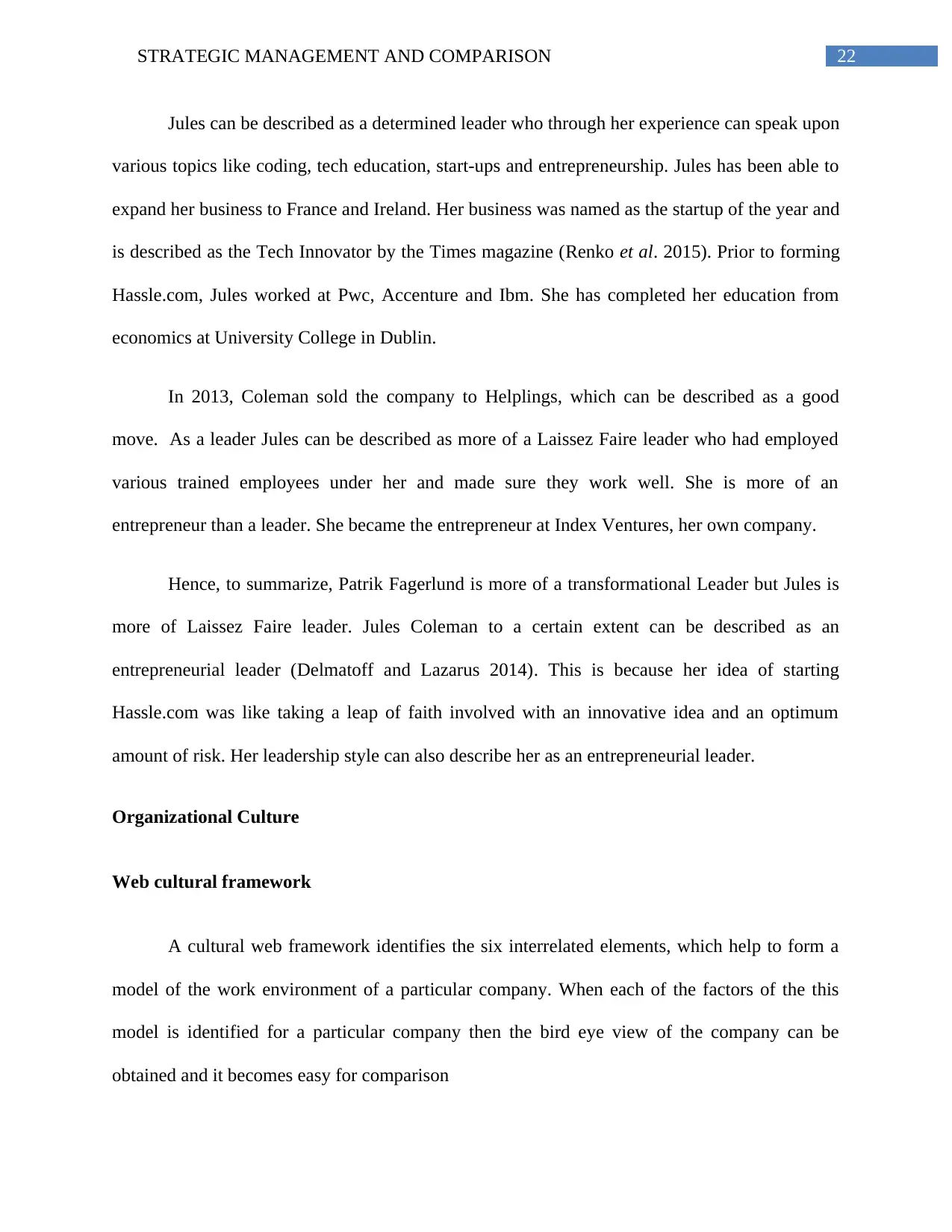
22STRATEGIC MANAGEMENT AND COMPARISON
Jules can be described as a determined leader who through her experience can speak upon
various topics like coding, tech education, start-ups and entrepreneurship. Jules has been able to
expand her business to France and Ireland. Her business was named as the startup of the year and
is described as the Tech Innovator by the Times magazine (Renko et al. 2015). Prior to forming
Hassle.com, Jules worked at Pwc, Accenture and Ibm. She has completed her education from
economics at University College in Dublin.
In 2013, Coleman sold the company to Helplings, which can be described as a good
move. As a leader Jules can be described as more of a Laissez Faire leader who had employed
various trained employees under her and made sure they work well. She is more of an
entrepreneur than a leader. She became the entrepreneur at Index Ventures, her own company.
Hence, to summarize, Patrik Fagerlund is more of a transformational Leader but Jules is
more of Laissez Faire leader. Jules Coleman to a certain extent can be described as an
entrepreneurial leader (Delmatoff and Lazarus 2014). This is because her idea of starting
Hassle.com was like taking a leap of faith involved with an innovative idea and an optimum
amount of risk. Her leadership style can also describe her as an entrepreneurial leader.
Organizational Culture
Web cultural framework
A cultural web framework identifies the six interrelated elements, which help to form a
model of the work environment of a particular company. When each of the factors of the this
model is identified for a particular company then the bird eye view of the company can be
obtained and it becomes easy for comparison
Jules can be described as a determined leader who through her experience can speak upon
various topics like coding, tech education, start-ups and entrepreneurship. Jules has been able to
expand her business to France and Ireland. Her business was named as the startup of the year and
is described as the Tech Innovator by the Times magazine (Renko et al. 2015). Prior to forming
Hassle.com, Jules worked at Pwc, Accenture and Ibm. She has completed her education from
economics at University College in Dublin.
In 2013, Coleman sold the company to Helplings, which can be described as a good
move. As a leader Jules can be described as more of a Laissez Faire leader who had employed
various trained employees under her and made sure they work well. She is more of an
entrepreneur than a leader. She became the entrepreneur at Index Ventures, her own company.
Hence, to summarize, Patrik Fagerlund is more of a transformational Leader but Jules is
more of Laissez Faire leader. Jules Coleman to a certain extent can be described as an
entrepreneurial leader (Delmatoff and Lazarus 2014). This is because her idea of starting
Hassle.com was like taking a leap of faith involved with an innovative idea and an optimum
amount of risk. Her leadership style can also describe her as an entrepreneurial leader.
Organizational Culture
Web cultural framework
A cultural web framework identifies the six interrelated elements, which help to form a
model of the work environment of a particular company. When each of the factors of the this
model is identified for a particular company then the bird eye view of the company can be
obtained and it becomes easy for comparison
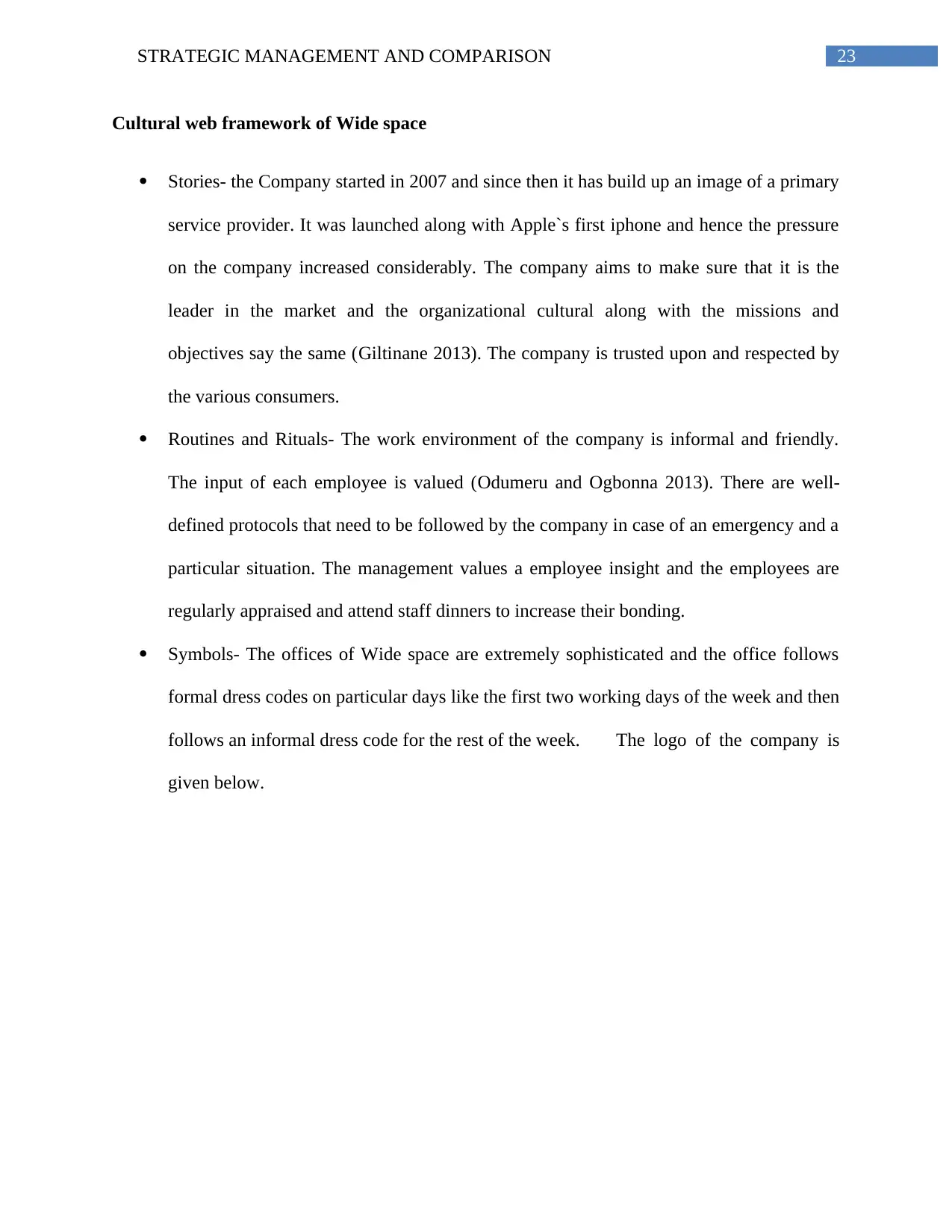
23STRATEGIC MANAGEMENT AND COMPARISON
Cultural web framework of Wide space
Stories- the Company started in 2007 and since then it has build up an image of a primary
service provider. It was launched along with Apple`s first iphone and hence the pressure
on the company increased considerably. The company aims to make sure that it is the
leader in the market and the organizational cultural along with the missions and
objectives say the same (Giltinane 2013). The company is trusted upon and respected by
the various consumers.
Routines and Rituals- The work environment of the company is informal and friendly.
The input of each employee is valued (Odumeru and Ogbonna 2013). There are well-
defined protocols that need to be followed by the company in case of an emergency and a
particular situation. The management values a employee insight and the employees are
regularly appraised and attend staff dinners to increase their bonding.
Symbols- The offices of Wide space are extremely sophisticated and the office follows
formal dress codes on particular days like the first two working days of the week and then
follows an informal dress code for the rest of the week. The logo of the company is
given below.
Cultural web framework of Wide space
Stories- the Company started in 2007 and since then it has build up an image of a primary
service provider. It was launched along with Apple`s first iphone and hence the pressure
on the company increased considerably. The company aims to make sure that it is the
leader in the market and the organizational cultural along with the missions and
objectives say the same (Giltinane 2013). The company is trusted upon and respected by
the various consumers.
Routines and Rituals- The work environment of the company is informal and friendly.
The input of each employee is valued (Odumeru and Ogbonna 2013). There are well-
defined protocols that need to be followed by the company in case of an emergency and a
particular situation. The management values a employee insight and the employees are
regularly appraised and attend staff dinners to increase their bonding.
Symbols- The offices of Wide space are extremely sophisticated and the office follows
formal dress codes on particular days like the first two working days of the week and then
follows an informal dress code for the rest of the week. The logo of the company is
given below.
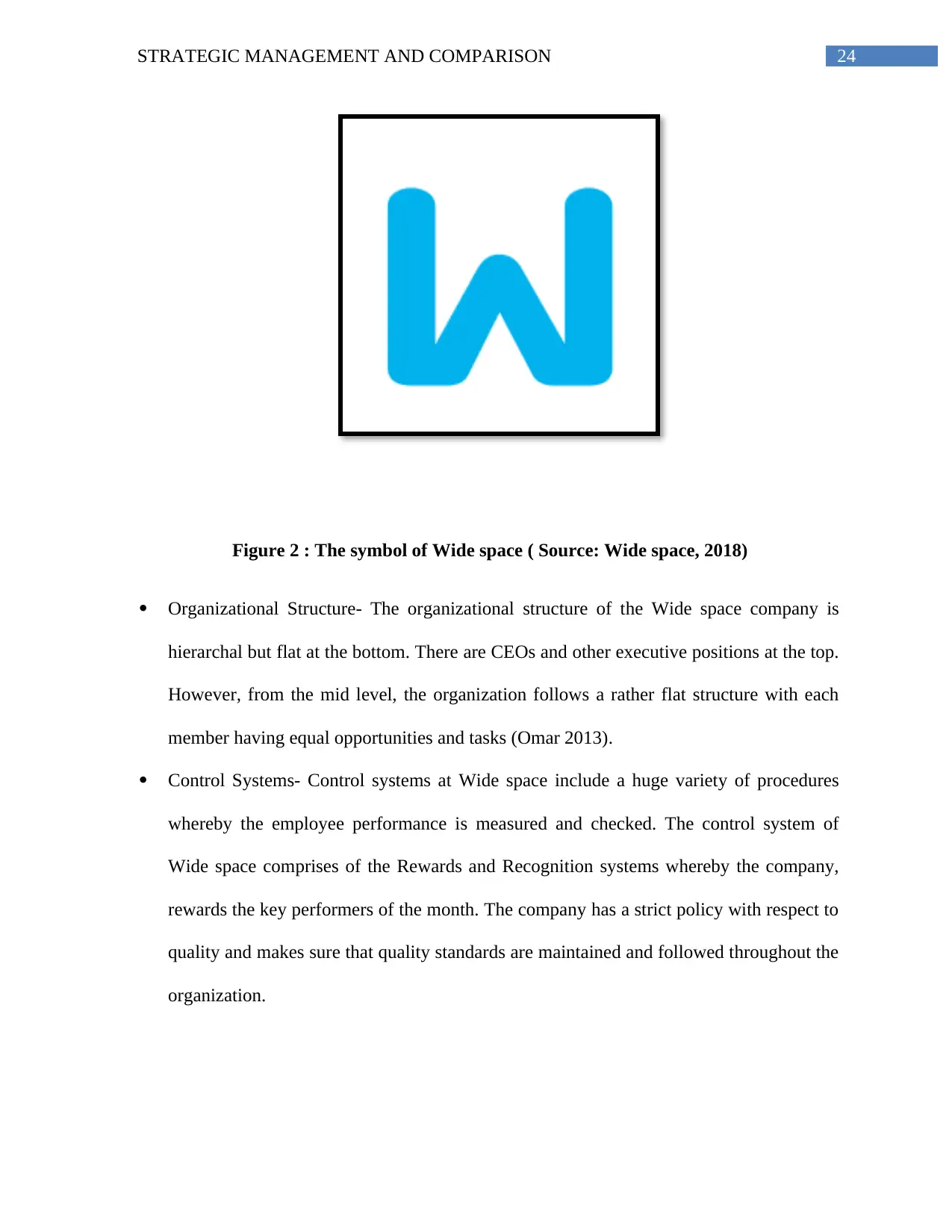
24STRATEGIC MANAGEMENT AND COMPARISON
Figure 2 : The symbol of Wide space ( Source: Wide space, 2018)
Organizational Structure- The organizational structure of the Wide space company is
hierarchal but flat at the bottom. There are CEOs and other executive positions at the top.
However, from the mid level, the organization follows a rather flat structure with each
member having equal opportunities and tasks (Omar 2013).
Control Systems- Control systems at Wide space include a huge variety of procedures
whereby the employee performance is measured and checked. The control system of
Wide space comprises of the Rewards and Recognition systems whereby the company,
rewards the key performers of the month. The company has a strict policy with respect to
quality and makes sure that quality standards are maintained and followed throughout the
organization.
Figure 2 : The symbol of Wide space ( Source: Wide space, 2018)
Organizational Structure- The organizational structure of the Wide space company is
hierarchal but flat at the bottom. There are CEOs and other executive positions at the top.
However, from the mid level, the organization follows a rather flat structure with each
member having equal opportunities and tasks (Omar 2013).
Control Systems- Control systems at Wide space include a huge variety of procedures
whereby the employee performance is measured and checked. The control system of
Wide space comprises of the Rewards and Recognition systems whereby the company,
rewards the key performers of the month. The company has a strict policy with respect to
quality and makes sure that quality standards are maintained and followed throughout the
organization.
Paraphrase This Document
Need a fresh take? Get an instant paraphrase of this document with our AI Paraphraser
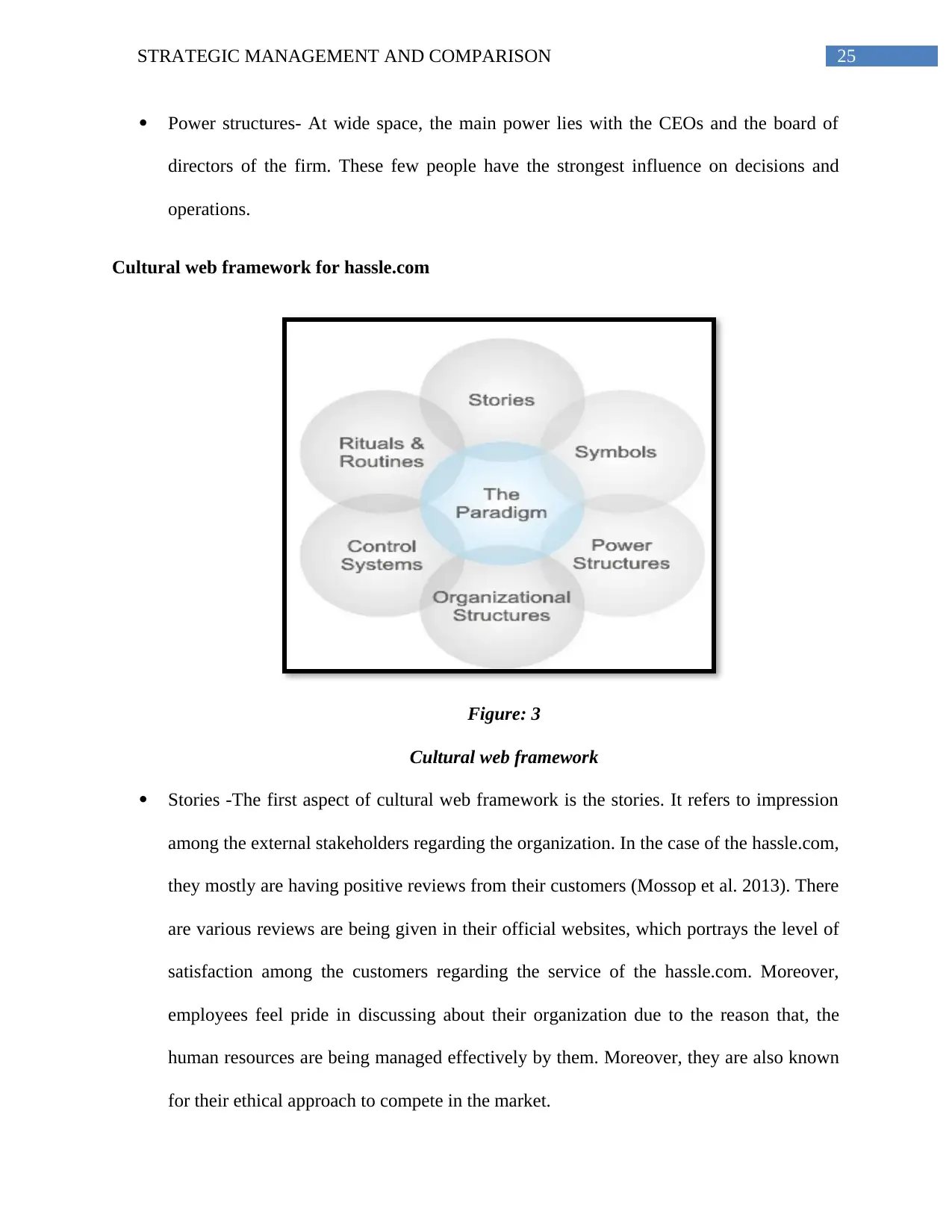
25STRATEGIC MANAGEMENT AND COMPARISON
Power structures- At wide space, the main power lies with the CEOs and the board of
directors of the firm. These few people have the strongest influence on decisions and
operations.
Cultural web framework for hassle.com
Figure: 3
Cultural web framework
Stories -The first aspect of cultural web framework is the stories. It refers to impression
among the external stakeholders regarding the organization. In the case of the hassle.com,
they mostly are having positive reviews from their customers (Mossop et al. 2013). There
are various reviews are being given in their official websites, which portrays the level of
satisfaction among the customers regarding the service of the hassle.com. Moreover,
employees feel pride in discussing about their organization due to the reason that, the
human resources are being managed effectively by them. Moreover, they are also known
for their ethical approach to compete in the market.
Power structures- At wide space, the main power lies with the CEOs and the board of
directors of the firm. These few people have the strongest influence on decisions and
operations.
Cultural web framework for hassle.com
Figure: 3
Cultural web framework
Stories -The first aspect of cultural web framework is the stories. It refers to impression
among the external stakeholders regarding the organization. In the case of the hassle.com,
they mostly are having positive reviews from their customers (Mossop et al. 2013). There
are various reviews are being given in their official websites, which portrays the level of
satisfaction among the customers regarding the service of the hassle.com. Moreover,
employees feel pride in discussing about their organization due to the reason that, the
human resources are being managed effectively by them. Moreover, they are also known
for their ethical approach to compete in the market.
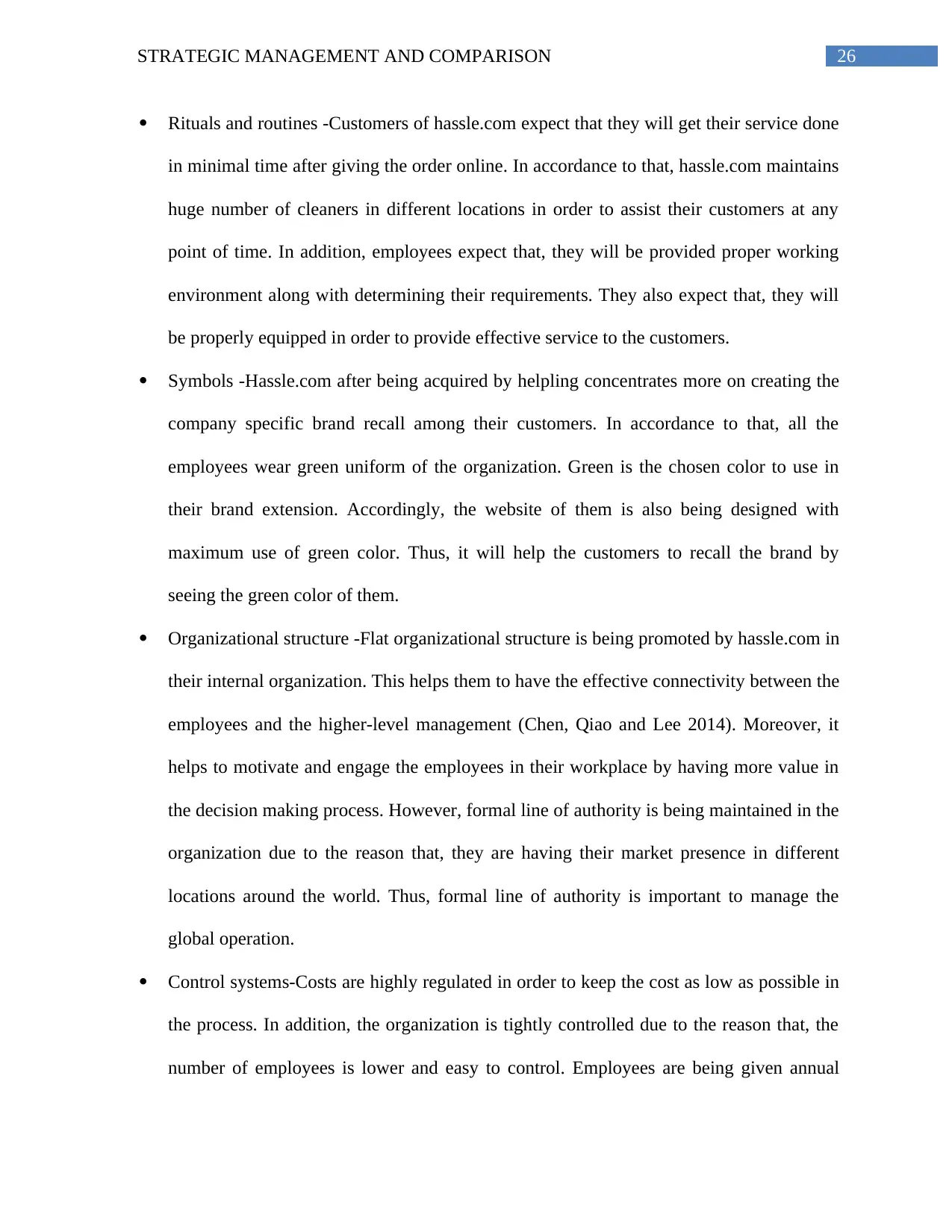
26STRATEGIC MANAGEMENT AND COMPARISON
Rituals and routines -Customers of hassle.com expect that they will get their service done
in minimal time after giving the order online. In accordance to that, hassle.com maintains
huge number of cleaners in different locations in order to assist their customers at any
point of time. In addition, employees expect that, they will be provided proper working
environment along with determining their requirements. They also expect that, they will
be properly equipped in order to provide effective service to the customers.
Symbols -Hassle.com after being acquired by helpling concentrates more on creating the
company specific brand recall among their customers. In accordance to that, all the
employees wear green uniform of the organization. Green is the chosen color to use in
their brand extension. Accordingly, the website of them is also being designed with
maximum use of green color. Thus, it will help the customers to recall the brand by
seeing the green color of them.
Organizational structure -Flat organizational structure is being promoted by hassle.com in
their internal organization. This helps them to have the effective connectivity between the
employees and the higher-level management (Chen, Qiao and Lee 2014). Moreover, it
helps to motivate and engage the employees in their workplace by having more value in
the decision making process. However, formal line of authority is being maintained in the
organization due to the reason that, they are having their market presence in different
locations around the world. Thus, formal line of authority is important to manage the
global operation.
Control systems-Costs are highly regulated in order to keep the cost as low as possible in
the process. In addition, the organization is tightly controlled due to the reason that, the
number of employees is lower and easy to control. Employees are being given annual
Rituals and routines -Customers of hassle.com expect that they will get their service done
in minimal time after giving the order online. In accordance to that, hassle.com maintains
huge number of cleaners in different locations in order to assist their customers at any
point of time. In addition, employees expect that, they will be provided proper working
environment along with determining their requirements. They also expect that, they will
be properly equipped in order to provide effective service to the customers.
Symbols -Hassle.com after being acquired by helpling concentrates more on creating the
company specific brand recall among their customers. In accordance to that, all the
employees wear green uniform of the organization. Green is the chosen color to use in
their brand extension. Accordingly, the website of them is also being designed with
maximum use of green color. Thus, it will help the customers to recall the brand by
seeing the green color of them.
Organizational structure -Flat organizational structure is being promoted by hassle.com in
their internal organization. This helps them to have the effective connectivity between the
employees and the higher-level management (Chen, Qiao and Lee 2014). Moreover, it
helps to motivate and engage the employees in their workplace by having more value in
the decision making process. However, formal line of authority is being maintained in the
organization due to the reason that, they are having their market presence in different
locations around the world. Thus, formal line of authority is important to manage the
global operation.
Control systems-Costs are highly regulated in order to keep the cost as low as possible in
the process. In addition, the organization is tightly controlled due to the reason that, the
number of employees is lower and easy to control. Employees are being given annual
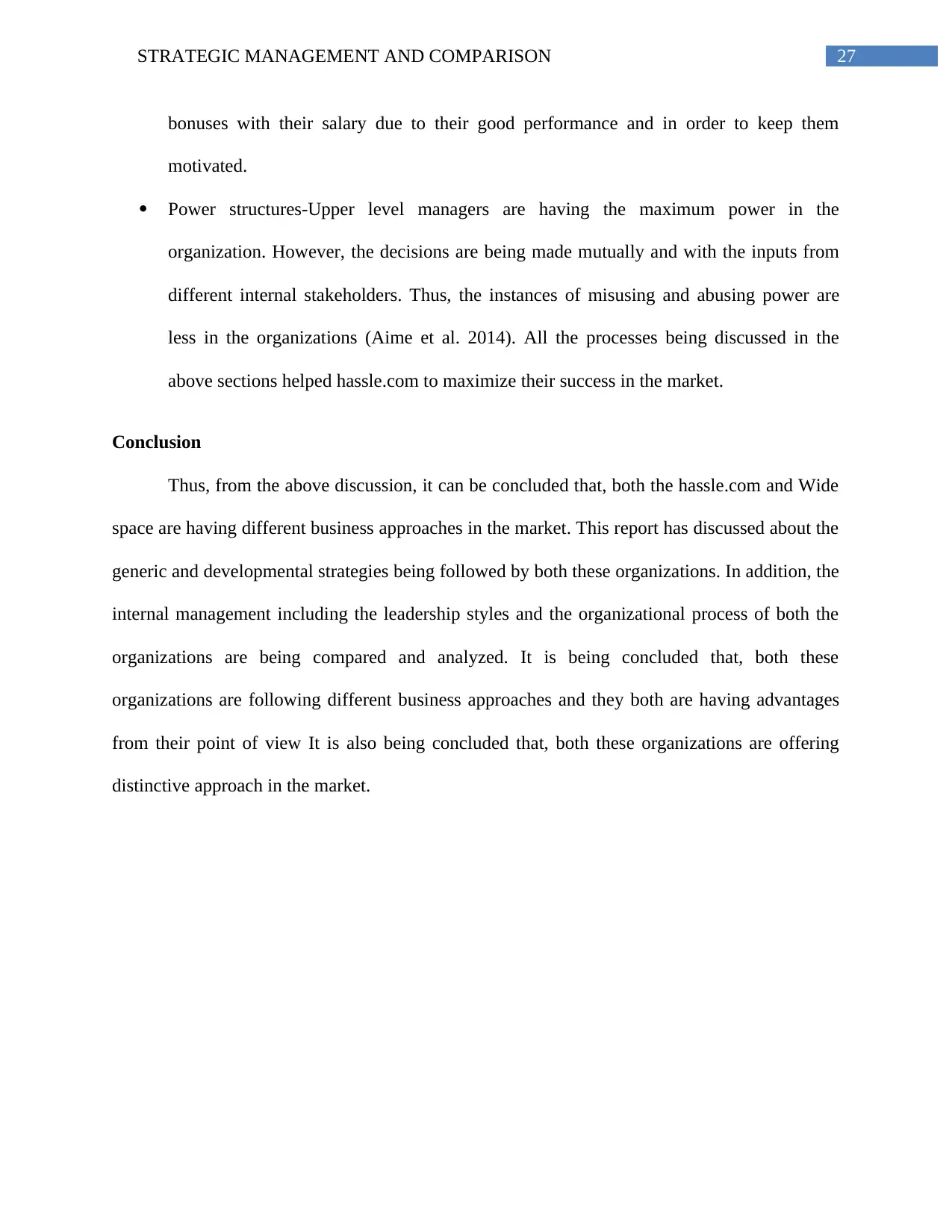
27STRATEGIC MANAGEMENT AND COMPARISON
bonuses with their salary due to their good performance and in order to keep them
motivated.
Power structures-Upper level managers are having the maximum power in the
organization. However, the decisions are being made mutually and with the inputs from
different internal stakeholders. Thus, the instances of misusing and abusing power are
less in the organizations (Aime et al. 2014). All the processes being discussed in the
above sections helped hassle.com to maximize their success in the market.
Conclusion
Thus, from the above discussion, it can be concluded that, both the hassle.com and Wide
space are having different business approaches in the market. This report has discussed about the
generic and developmental strategies being followed by both these organizations. In addition, the
internal management including the leadership styles and the organizational process of both the
organizations are being compared and analyzed. It is being concluded that, both these
organizations are following different business approaches and they both are having advantages
from their point of view It is also being concluded that, both these organizations are offering
distinctive approach in the market.
bonuses with their salary due to their good performance and in order to keep them
motivated.
Power structures-Upper level managers are having the maximum power in the
organization. However, the decisions are being made mutually and with the inputs from
different internal stakeholders. Thus, the instances of misusing and abusing power are
less in the organizations (Aime et al. 2014). All the processes being discussed in the
above sections helped hassle.com to maximize their success in the market.
Conclusion
Thus, from the above discussion, it can be concluded that, both the hassle.com and Wide
space are having different business approaches in the market. This report has discussed about the
generic and developmental strategies being followed by both these organizations. In addition, the
internal management including the leadership styles and the organizational process of both the
organizations are being compared and analyzed. It is being concluded that, both these
organizations are following different business approaches and they both are having advantages
from their point of view It is also being concluded that, both these organizations are offering
distinctive approach in the market.
Secure Best Marks with AI Grader
Need help grading? Try our AI Grader for instant feedback on your assignments.
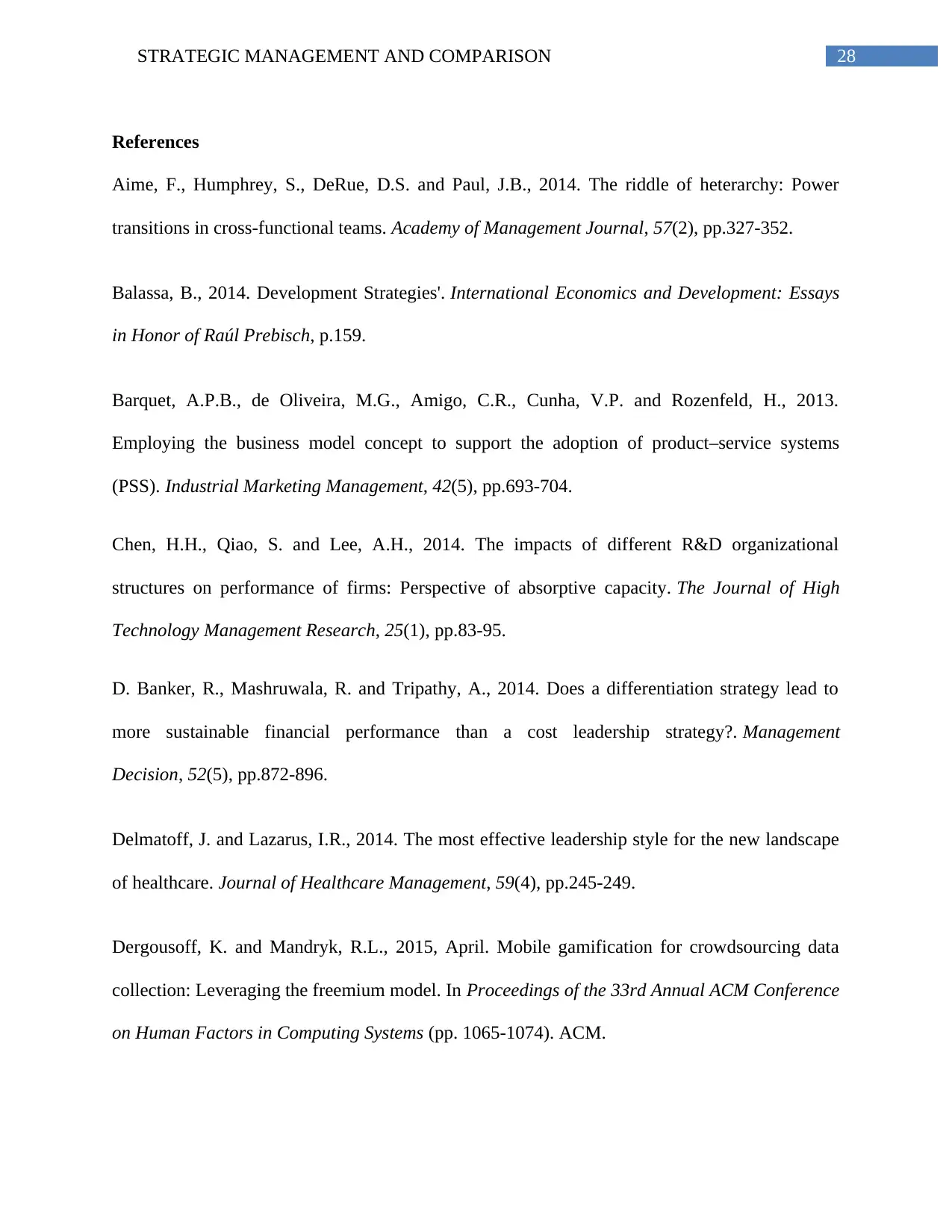
28STRATEGIC MANAGEMENT AND COMPARISON
References
Aime, F., Humphrey, S., DeRue, D.S. and Paul, J.B., 2014. The riddle of heterarchy: Power
transitions in cross-functional teams. Academy of Management Journal, 57(2), pp.327-352.
Balassa, B., 2014. Development Strategies'. International Economics and Development: Essays
in Honor of Raúl Prebisch, p.159.
Barquet, A.P.B., de Oliveira, M.G., Amigo, C.R., Cunha, V.P. and Rozenfeld, H., 2013.
Employing the business model concept to support the adoption of product–service systems
(PSS). Industrial Marketing Management, 42(5), pp.693-704.
Chen, H.H., Qiao, S. and Lee, A.H., 2014. The impacts of different R&D organizational
structures on performance of firms: Perspective of absorptive capacity. The Journal of High
Technology Management Research, 25(1), pp.83-95.
D. Banker, R., Mashruwala, R. and Tripathy, A., 2014. Does a differentiation strategy lead to
more sustainable financial performance than a cost leadership strategy?. Management
Decision, 52(5), pp.872-896.
Delmatoff, J. and Lazarus, I.R., 2014. The most effective leadership style for the new landscape
of healthcare. Journal of Healthcare Management, 59(4), pp.245-249.
Dergousoff, K. and Mandryk, R.L., 2015, April. Mobile gamification for crowdsourcing data
collection: Leveraging the freemium model. In Proceedings of the 33rd Annual ACM Conference
on Human Factors in Computing Systems (pp. 1065-1074). ACM.
References
Aime, F., Humphrey, S., DeRue, D.S. and Paul, J.B., 2014. The riddle of heterarchy: Power
transitions in cross-functional teams. Academy of Management Journal, 57(2), pp.327-352.
Balassa, B., 2014. Development Strategies'. International Economics and Development: Essays
in Honor of Raúl Prebisch, p.159.
Barquet, A.P.B., de Oliveira, M.G., Amigo, C.R., Cunha, V.P. and Rozenfeld, H., 2013.
Employing the business model concept to support the adoption of product–service systems
(PSS). Industrial Marketing Management, 42(5), pp.693-704.
Chen, H.H., Qiao, S. and Lee, A.H., 2014. The impacts of different R&D organizational
structures on performance of firms: Perspective of absorptive capacity. The Journal of High
Technology Management Research, 25(1), pp.83-95.
D. Banker, R., Mashruwala, R. and Tripathy, A., 2014. Does a differentiation strategy lead to
more sustainable financial performance than a cost leadership strategy?. Management
Decision, 52(5), pp.872-896.
Delmatoff, J. and Lazarus, I.R., 2014. The most effective leadership style for the new landscape
of healthcare. Journal of Healthcare Management, 59(4), pp.245-249.
Dergousoff, K. and Mandryk, R.L., 2015, April. Mobile gamification for crowdsourcing data
collection: Leveraging the freemium model. In Proceedings of the 33rd Annual ACM Conference
on Human Factors in Computing Systems (pp. 1065-1074). ACM.

29STRATEGIC MANAGEMENT AND COMPARISON
FinSMEs.com, 2014. Hassle.com, Interview with Alex Depledge. [online] FinSMEs. Available
at: http://www.finsmes.com/2014/06/hassle-com-interview-with-alex-depledge.html [Accessed
13 Jan. 2018].
Fosu, A.K. ed., 2013. Achieving development success: Strategies and lessons from the
developing world. Oxford University Press.
Giltinane, C.L., 2013. Leadership styles and theories. Nursing standard, 27(41), pp.35-39.
Gomes, E., Angwin, D.N., Weber, Y. and Yedidia Tarba, S., 2013. Critical success factors
through the mergers and acquisitions process: revealing pre‐and post‐M&A connections for
improved performance. Thunderbird international business review, 55(1), pp.13-35.
Grant, R.M., 2016. Contemporary strategy analysis: Text and cases edition. John Wiley & Sons.
Gurung, A. and Prater, E., 2017. A research framework for the impact of cultural differences on
IT outsourcing. In Global Sourcing of Services: Strategies, Issues and Challenges (pp. 49-82).
Helpling.co.uk, 2018. Find domestic cleaners near you | Helpling. [online] Helpling.co.uk.
Available at: https://www.helpling.co.uk/ [Accessed 13 Jan. 2018].
Hoberg, G. and Phillips, G., 2016. Text-based network industries and endogenous product
differentiation. Journal of Political Economy, 124(5), pp.1423-1465.
Kara, D., Uysal, M., Sirgy, M.J. and Lee, G., 2013. The effects of leadership style on employee
well-being in hospitality. International Journal of Hospitality Management, 34, pp.9-18.
FinSMEs.com, 2014. Hassle.com, Interview with Alex Depledge. [online] FinSMEs. Available
at: http://www.finsmes.com/2014/06/hassle-com-interview-with-alex-depledge.html [Accessed
13 Jan. 2018].
Fosu, A.K. ed., 2013. Achieving development success: Strategies and lessons from the
developing world. Oxford University Press.
Giltinane, C.L., 2013. Leadership styles and theories. Nursing standard, 27(41), pp.35-39.
Gomes, E., Angwin, D.N., Weber, Y. and Yedidia Tarba, S., 2013. Critical success factors
through the mergers and acquisitions process: revealing pre‐and post‐M&A connections for
improved performance. Thunderbird international business review, 55(1), pp.13-35.
Grant, R.M., 2016. Contemporary strategy analysis: Text and cases edition. John Wiley & Sons.
Gurung, A. and Prater, E., 2017. A research framework for the impact of cultural differences on
IT outsourcing. In Global Sourcing of Services: Strategies, Issues and Challenges (pp. 49-82).
Helpling.co.uk, 2018. Find domestic cleaners near you | Helpling. [online] Helpling.co.uk.
Available at: https://www.helpling.co.uk/ [Accessed 13 Jan. 2018].
Hoberg, G. and Phillips, G., 2016. Text-based network industries and endogenous product
differentiation. Journal of Political Economy, 124(5), pp.1423-1465.
Kara, D., Uysal, M., Sirgy, M.J. and Lee, G., 2013. The effects of leadership style on employee
well-being in hospitality. International Journal of Hospitality Management, 34, pp.9-18.
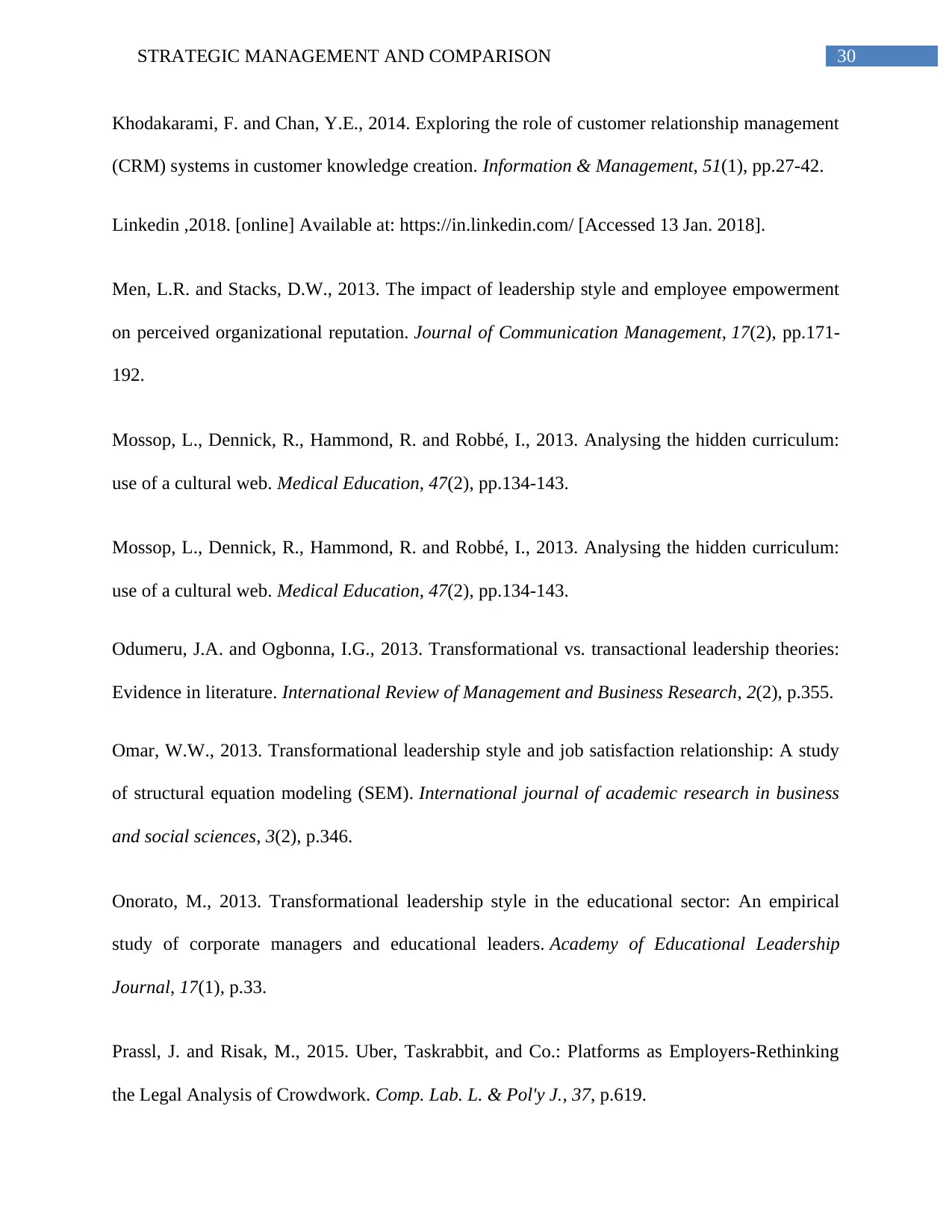
30STRATEGIC MANAGEMENT AND COMPARISON
Khodakarami, F. and Chan, Y.E., 2014. Exploring the role of customer relationship management
(CRM) systems in customer knowledge creation. Information & Management, 51(1), pp.27-42.
Linkedin ,2018. [online] Available at: https://in.linkedin.com/ [Accessed 13 Jan. 2018].
Men, L.R. and Stacks, D.W., 2013. The impact of leadership style and employee empowerment
on perceived organizational reputation. Journal of Communication Management, 17(2), pp.171-
192.
Mossop, L., Dennick, R., Hammond, R. and Robbé, I., 2013. Analysing the hidden curriculum:
use of a cultural web. Medical Education, 47(2), pp.134-143.
Mossop, L., Dennick, R., Hammond, R. and Robbé, I., 2013. Analysing the hidden curriculum:
use of a cultural web. Medical Education, 47(2), pp.134-143.
Odumeru, J.A. and Ogbonna, I.G., 2013. Transformational vs. transactional leadership theories:
Evidence in literature. International Review of Management and Business Research, 2(2), p.355.
Omar, W.W., 2013. Transformational leadership style and job satisfaction relationship: A study
of structural equation modeling (SEM). International journal of academic research in business
and social sciences, 3(2), p.346.
Onorato, M., 2013. Transformational leadership style in the educational sector: An empirical
study of corporate managers and educational leaders. Academy of Educational Leadership
Journal, 17(1), p.33.
Prassl, J. and Risak, M., 2015. Uber, Taskrabbit, and Co.: Platforms as Employers-Rethinking
the Legal Analysis of Crowdwork. Comp. Lab. L. & Pol'y J., 37, p.619.
Khodakarami, F. and Chan, Y.E., 2014. Exploring the role of customer relationship management
(CRM) systems in customer knowledge creation. Information & Management, 51(1), pp.27-42.
Linkedin ,2018. [online] Available at: https://in.linkedin.com/ [Accessed 13 Jan. 2018].
Men, L.R. and Stacks, D.W., 2013. The impact of leadership style and employee empowerment
on perceived organizational reputation. Journal of Communication Management, 17(2), pp.171-
192.
Mossop, L., Dennick, R., Hammond, R. and Robbé, I., 2013. Analysing the hidden curriculum:
use of a cultural web. Medical Education, 47(2), pp.134-143.
Mossop, L., Dennick, R., Hammond, R. and Robbé, I., 2013. Analysing the hidden curriculum:
use of a cultural web. Medical Education, 47(2), pp.134-143.
Odumeru, J.A. and Ogbonna, I.G., 2013. Transformational vs. transactional leadership theories:
Evidence in literature. International Review of Management and Business Research, 2(2), p.355.
Omar, W.W., 2013. Transformational leadership style and job satisfaction relationship: A study
of structural equation modeling (SEM). International journal of academic research in business
and social sciences, 3(2), p.346.
Onorato, M., 2013. Transformational leadership style in the educational sector: An empirical
study of corporate managers and educational leaders. Academy of Educational Leadership
Journal, 17(1), p.33.
Prassl, J. and Risak, M., 2015. Uber, Taskrabbit, and Co.: Platforms as Employers-Rethinking
the Legal Analysis of Crowdwork. Comp. Lab. L. & Pol'y J., 37, p.619.
Paraphrase This Document
Need a fresh take? Get an instant paraphrase of this document with our AI Paraphraser
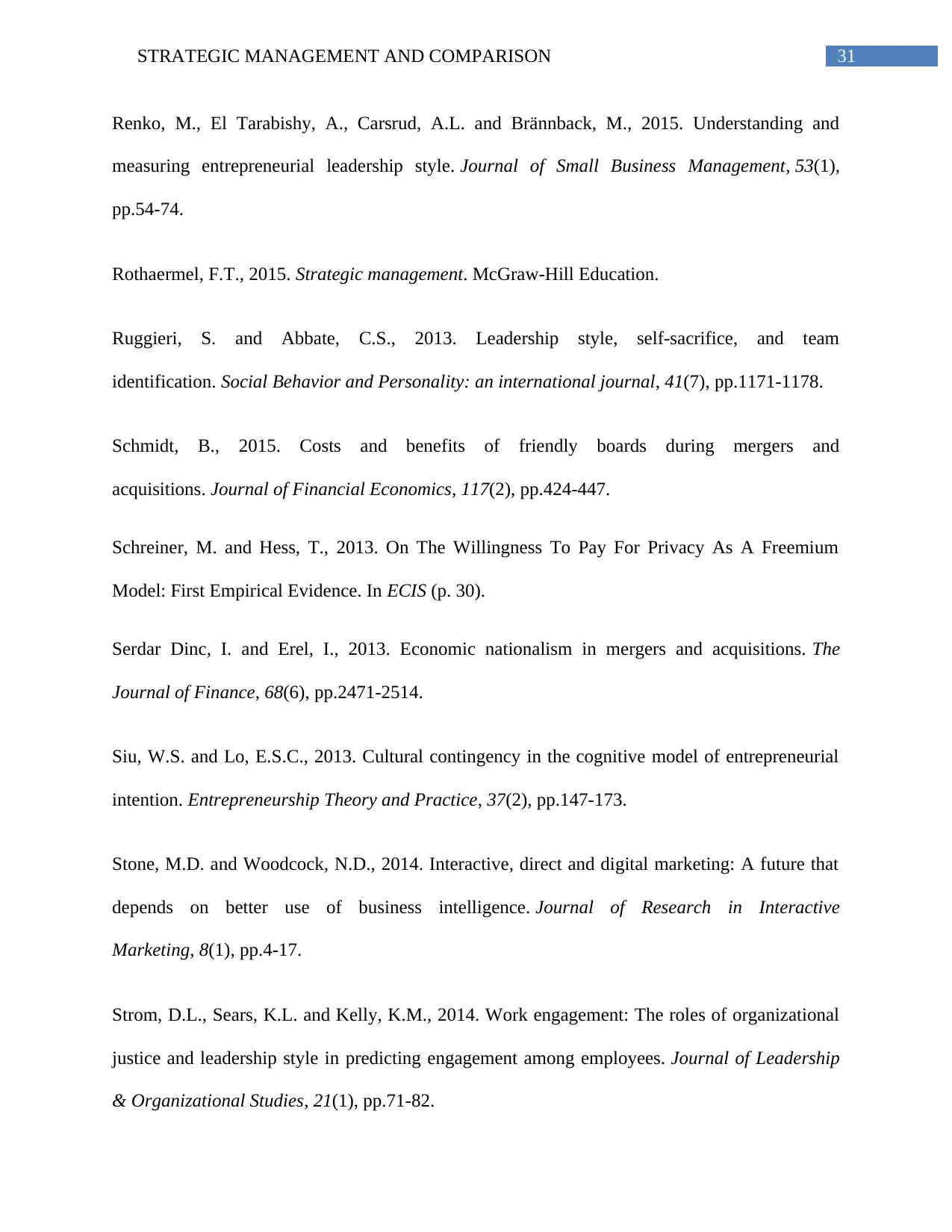
31STRATEGIC MANAGEMENT AND COMPARISON
Renko, M., El Tarabishy, A., Carsrud, A.L. and Brännback, M., 2015. Understanding and
measuring entrepreneurial leadership style. Journal of Small Business Management, 53(1),
pp.54-74.
Rothaermel, F.T., 2015. Strategic management. McGraw-Hill Education.
Ruggieri, S. and Abbate, C.S., 2013. Leadership style, self-sacrifice, and team
identification. Social Behavior and Personality: an international journal, 41(7), pp.1171-1178.
Schmidt, B., 2015. Costs and benefits of friendly boards during mergers and
acquisitions. Journal of Financial Economics, 117(2), pp.424-447.
Schreiner, M. and Hess, T., 2013. On The Willingness To Pay For Privacy As A Freemium
Model: First Empirical Evidence. In ECIS (p. 30).
Serdar Dinc, I. and Erel, I., 2013. Economic nationalism in mergers and acquisitions. The
Journal of Finance, 68(6), pp.2471-2514.
Siu, W.S. and Lo, E.S.C., 2013. Cultural contingency in the cognitive model of entrepreneurial
intention. Entrepreneurship Theory and Practice, 37(2), pp.147-173.
Stone, M.D. and Woodcock, N.D., 2014. Interactive, direct and digital marketing: A future that
depends on better use of business intelligence. Journal of Research in Interactive
Marketing, 8(1), pp.4-17.
Strom, D.L., Sears, K.L. and Kelly, K.M., 2014. Work engagement: The roles of organizational
justice and leadership style in predicting engagement among employees. Journal of Leadership
& Organizational Studies, 21(1), pp.71-82.
Renko, M., El Tarabishy, A., Carsrud, A.L. and Brännback, M., 2015. Understanding and
measuring entrepreneurial leadership style. Journal of Small Business Management, 53(1),
pp.54-74.
Rothaermel, F.T., 2015. Strategic management. McGraw-Hill Education.
Ruggieri, S. and Abbate, C.S., 2013. Leadership style, self-sacrifice, and team
identification. Social Behavior and Personality: an international journal, 41(7), pp.1171-1178.
Schmidt, B., 2015. Costs and benefits of friendly boards during mergers and
acquisitions. Journal of Financial Economics, 117(2), pp.424-447.
Schreiner, M. and Hess, T., 2013. On The Willingness To Pay For Privacy As A Freemium
Model: First Empirical Evidence. In ECIS (p. 30).
Serdar Dinc, I. and Erel, I., 2013. Economic nationalism in mergers and acquisitions. The
Journal of Finance, 68(6), pp.2471-2514.
Siu, W.S. and Lo, E.S.C., 2013. Cultural contingency in the cognitive model of entrepreneurial
intention. Entrepreneurship Theory and Practice, 37(2), pp.147-173.
Stone, M.D. and Woodcock, N.D., 2014. Interactive, direct and digital marketing: A future that
depends on better use of business intelligence. Journal of Research in Interactive
Marketing, 8(1), pp.4-17.
Strom, D.L., Sears, K.L. and Kelly, K.M., 2014. Work engagement: The roles of organizational
justice and leadership style in predicting engagement among employees. Journal of Leadership
& Organizational Studies, 21(1), pp.71-82.
1 out of 32
Related Documents
Your All-in-One AI-Powered Toolkit for Academic Success.
+13062052269
info@desklib.com
Available 24*7 on WhatsApp / Email
![[object Object]](/_next/static/media/star-bottom.7253800d.svg)
Unlock your academic potential
© 2024 | Zucol Services PVT LTD | All rights reserved.





